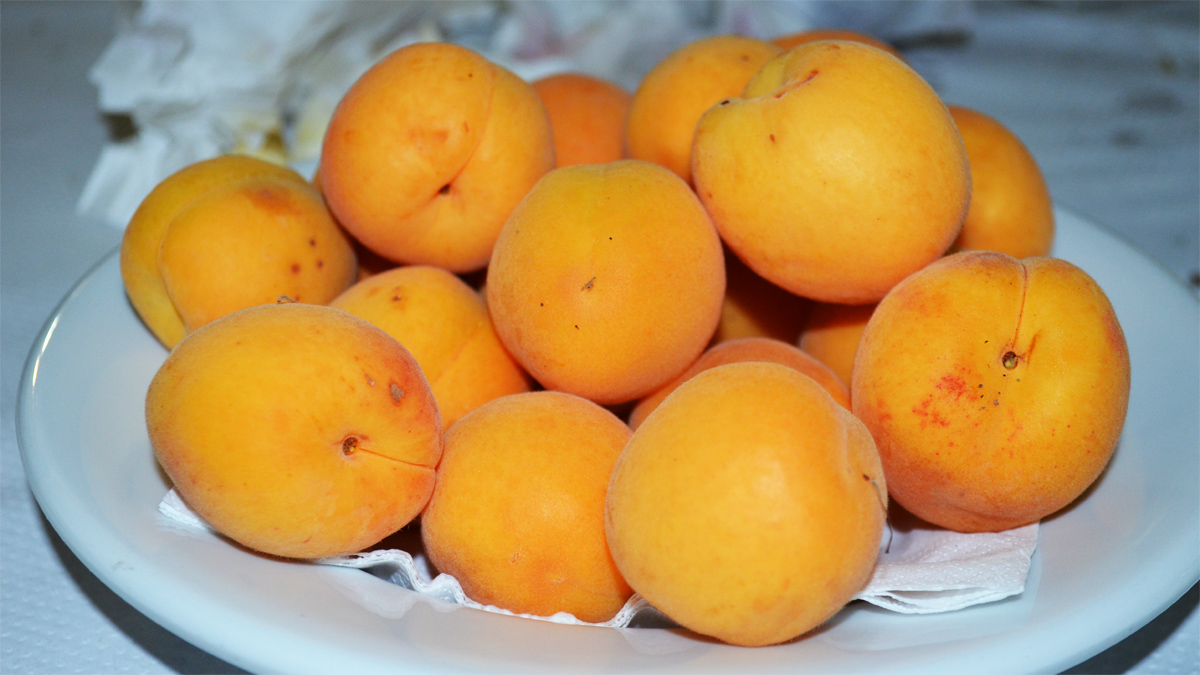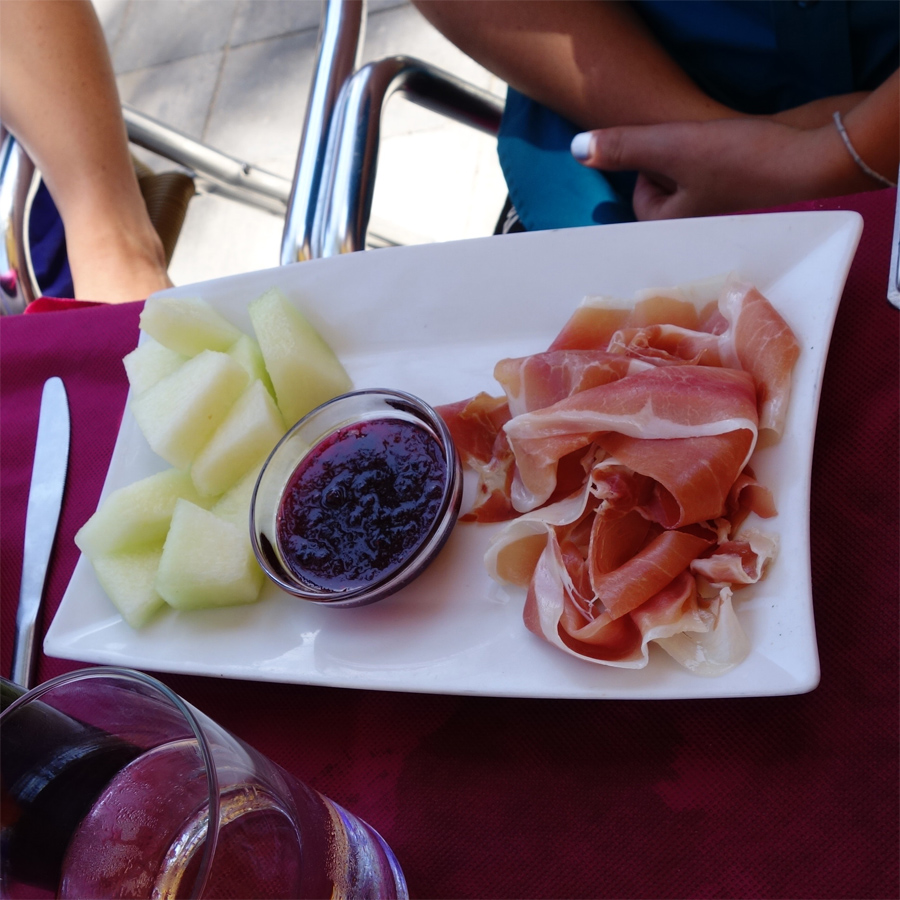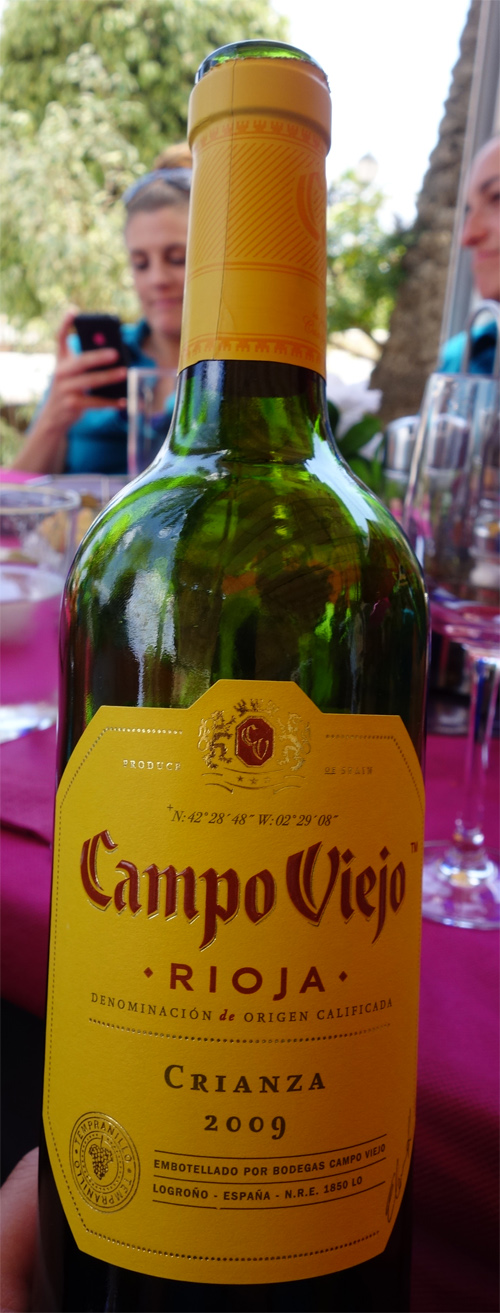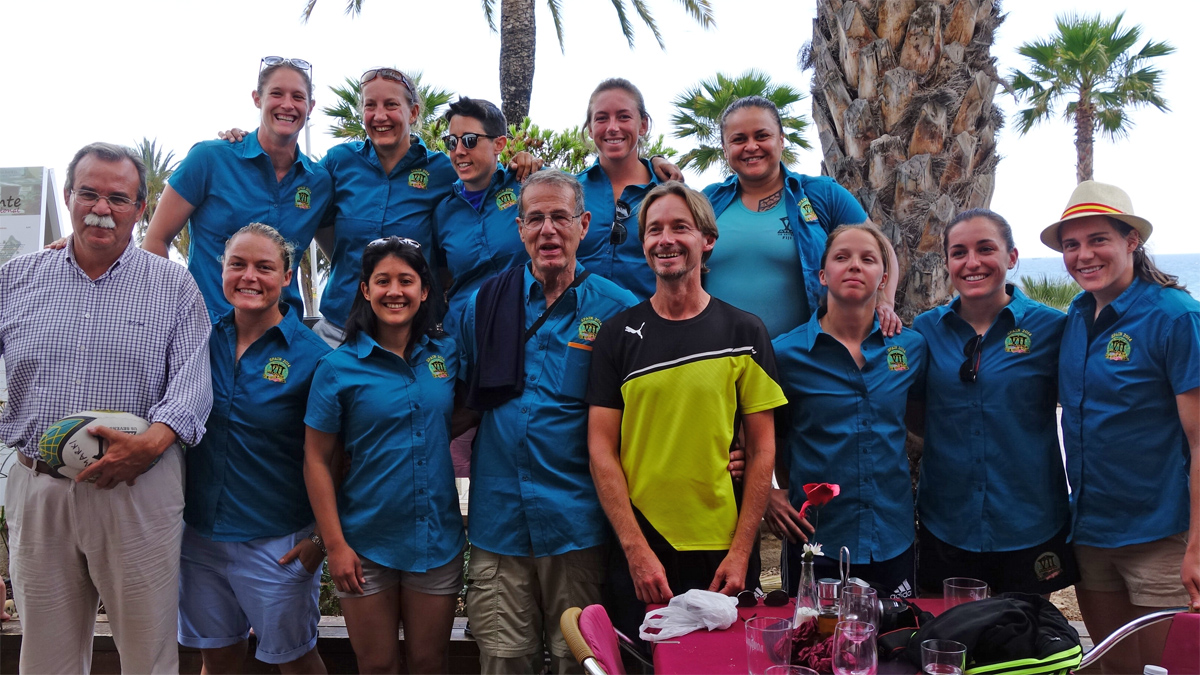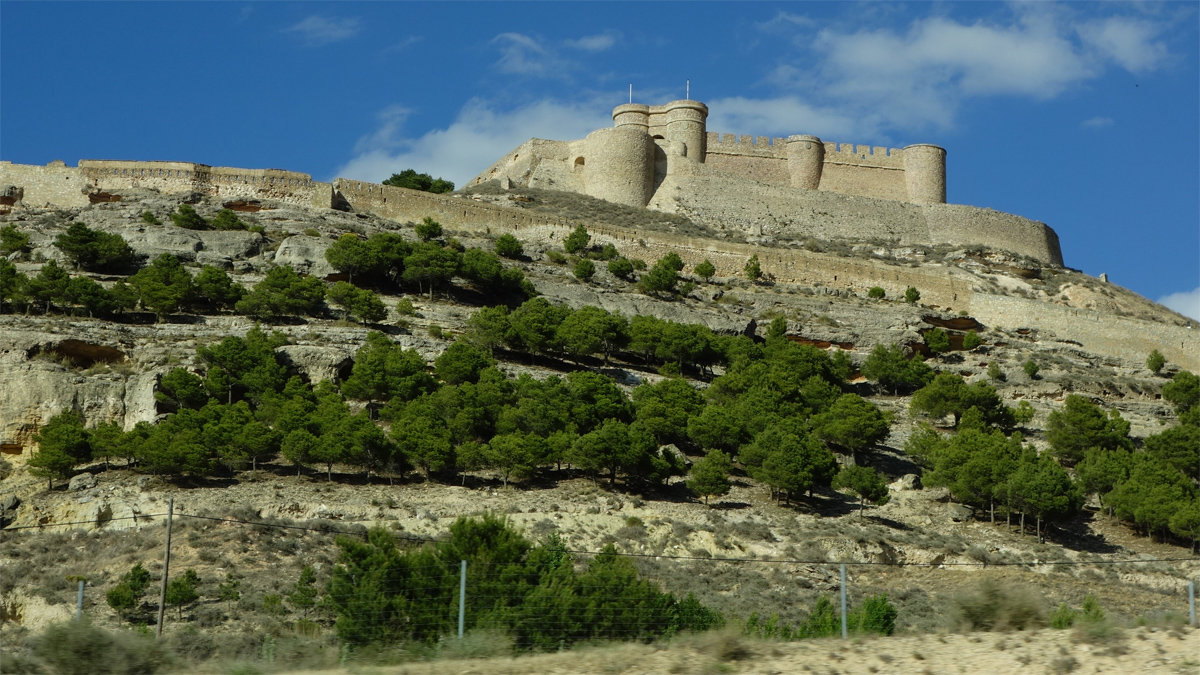May 2014: Atlantis Women in
Spain-II
By the Mediterranean (Benidorm,
Gata, la Vila Joiosa)
(Atlantis
tournament #144)
Emil Signes
JUNE 15, 2014 (rev. July 30, 2014)
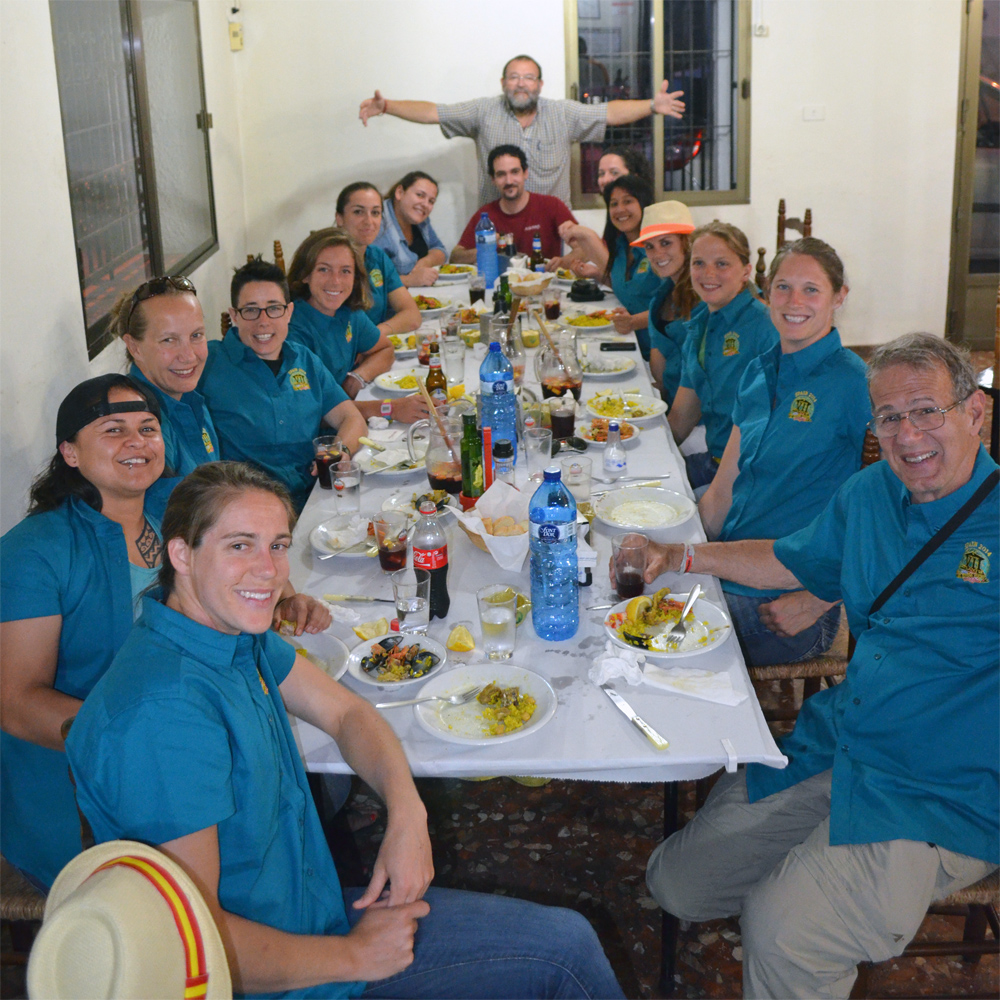 Team enjoying paella at Bar al
Pou ... In the back, cousin Antonio welcomes us
Team enjoying paella at Bar al
Pou ... In the back, cousin Antonio welcomes us
Or is he photobombing us?
0529c-cw-DSC_0785-Antonio
& team at table-ed-1000s.jpg
Thursday May 29
Ignacio Davila. It was nice of
Ignacio Davila to invite us to Benidorm for a practice and a meal:
our players got to jump in the Mediterranean and I got to take
them all to Gata de Gorgos, my father's hometown, where my cousin
Antonio owns a bar/restaurant. And we got to go Go-Karting; most
people that have been on Atlantis trips in the past know that's a
big event. It was all good.
When we found out that the women's division of the 2014 Benidorm
Sevens was canceled, I scrambled around to find something for us
to do, rugby-wise, and as mentioned above, James Gillenwater and
Álvaro Montero came to the rescue.
Ignacio had not, however, forgotten us. Shortly after Álvaro
had offered us activities in Madrid, Ignacio let me know there was
a Valencia Sevens on that same day - May 31 - and that he had
arranged for us to take part in that if we'd like. And also
arranged for us to visit Benidorm. I thanked him for his
consideration and noted that we'd already committed to Madrid, but
... could he still arrange for a visit to Benidorm? He said
sure, and we put together the middle two days of the tour. From
many previous trips to Benidorm I knew the team would enjoy being
on the Mediterranean at the beach, enjoy the beautiful beach-side
street of La Vila Joiosa (its Valencian name, it's Villajoyosa in
Castilian Spanish) with its beautifully painted buildings and
great restaurants, the exciting Go Kart tracks of Benidorm, and -
especially - keeping the tradition of Atlantis teams dining at my
cousin Antonio Signes Signes's bar-restaurant in Gata de Gorgos,
in a building that used to belong to my father.
I more or less made the decision for this side trip on my own,
because I knew the players would enjoy it, though I did run it by
Dana, who was fine with it.
Had we
stayed in Madrid we would have been able to get a couple more
practices in; as it was we were only able to practice
once. I felt, however, the upside of this diversion would
outweigh the loss of one practice. It was my job to make sure we
were adequately prepared for Saturday's tournament and I felt
one more practice would do it.
At any rate, if I'm taking a team on
tour that's paying all their own expenses my thought
process includes the following:
1. As a team, we have to enjoy ourselves. Or why would
anyone want to tour with me again?
2. If I select players that place a high priority on
making on-the-field results be an integral part of
enjoyment, then they'll figure out a way to mix
off-the-field fun with what they need to do.
3. A corollary of 2 is that all of us need to be willing
to prepare properly to maximize our probability of
winning. Prepare to win!
4. It helps to have players that are easy to get along
with and can combine fun with 2 and 3, above.
5. The key to success in achieving these goals clearly
lies in picking the right players.
If I've selected
the players properly, then by definition a
large component of enjoying ourselves will
include for the team, as it does for me,
success on the field, fueled by hard work on
the practice field... and treating our bodies
properly. Oh, and we'll have fun off the field
as well.
Dana put it far more succinctly: "I really enjoy coaching players that have a
carefree attitude mixed with a strong desire to work
hard and learn new things. The players on this
tour perfectly encapsulated all of those things."
Logistics. Manager Dana organized two two-day car rentals
from the Madrid airport. We got up early Thursday morning and
dropped off our bags at the Petit Palace on Puerta del Sol, the
hotel we would check into tomorrow night following our return from
the Mediterranean. We took cabs to the airport car rental place
and sometime around 9 AM we were on the road. The problem
was, on the road to where? Between our unaware GPS units and
road signs (I can't believe we didn't have a single detailed
hardcopy map among us) we still spent the first 20 minutes getting
closer to Madrid than vice-versa. Finally, however, the GPS
realized we were mistaken (which we already knew) and got us on
the road east. The majority of the road from Madrid to
Benidorm (we took the Alicante route) is spent in La Mancha, and
we passed a few large banks of windmills, utilizing the wind for
power, as they did in Don Quixote's day.
The photograph below shows the road signs shortly after leaving
Barajas airport. My recollection was that shortly after
leaving the airport we should get on the A-3 towards Valencia, and
from there it would be a piece of cake. But - no signs for
A-3, for Valencia, for ... nuttin. Our GPS units, set to
Benidorm, were still confused. Where is Rand McNally (or
Spanish equivalent) when you need it?
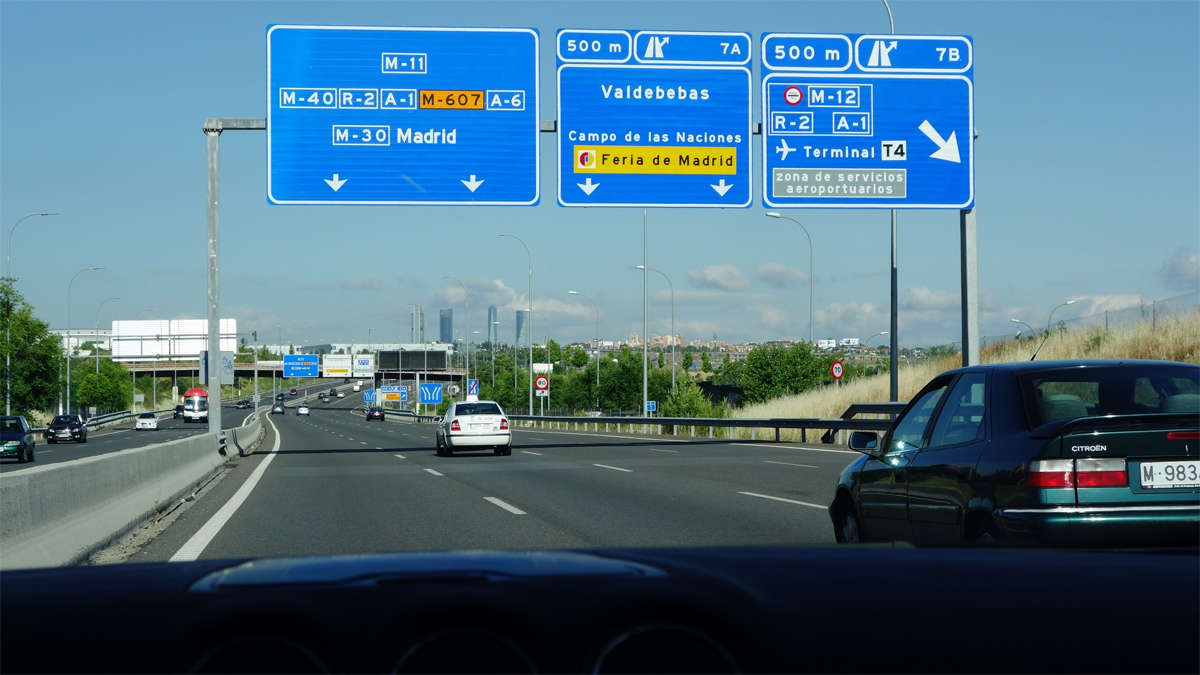 View on leaving the airport with
our rental cars: where the hell are we going?
0529a-mm-DSC03881-on
the road-ed-1200w.jpg
View on leaving the airport with
our rental cars: where the hell are we going?
0529a-mm-DSC03881-on
the road-ed-1200w.jpg
It probably cost us half an hour but eventually - somehow - we
found the A-3 and were on our way.
 Windmills in La Mancha: they don't
look like Don Quixote's enemies but they serve the same purpose
as in the 17th century.
0530d-mm-DSC04948-windmills
in La Mancha-ed-1200w.jpg
Windmills in La Mancha: they don't
look like Don Quixote's enemies but they serve the same purpose
as in the 17th century.
0530d-mm-DSC04948-windmills
in La Mancha-ed-1200w.jpg
Benidorm
We met Ignacio Davila at the
Villajoyosa exit and he took us to our hotel, the Apartamento
Pierre Vacances Benidorm, located just south of Benidorm and north
of La Vila. We got a light meal at a beachside restaurant,
and hit the beach. We returned in time to change and head to my
father's home town of Gata de Gorgos for an 8 PM dinner.
 At the beach on the
Mediterranean. Benidorm highrises in the background, left
0529b-cw-DSC_0624-Team
on Benidorm beach-ed-1200w.jpg
At the beach on the
Mediterranean. Benidorm highrises in the background, left
0529b-cw-DSC_0624-Team
on Benidorm beach-ed-1200w.jpg
The notch in
the mountain. There is an opening in the Puig Campana
mountain just west of Benidorm and a big rock in the sea: the
story I heard was that, ages ago, a big giant ripped out that
piece of mountain and threw it into the sea. To be a
good story, though, there must have been a reason he did that,
and I never heard any.
Following this visit, however, I discovered a more satisfying
version of the story courtesy of the Internet. "The
story goes," per holidaytruths.co.uk, "that a giant called
Roldan made the gap in the mountain because he had been told
that his wife would die when the sun set behind Puig Campana
summit, and by making the great big notch in the mountain.....
he would enable her to live longer."
I've stopped looking; this is a good enough story for me
(scientifically unrewarding though it may be).

 Upper: Puig Campana Mountain
with its famous hole
Upper: Puig Campana Mountain
with its famous hole
Lower: Benidorm Rock
0529b-mm-DSC04127-hole in
mountain-ed-1200w.jpg / 0529b-jz-IMG_6519-Benidorm
Rock-ed-1200w.jpg
Gata de Gorgos
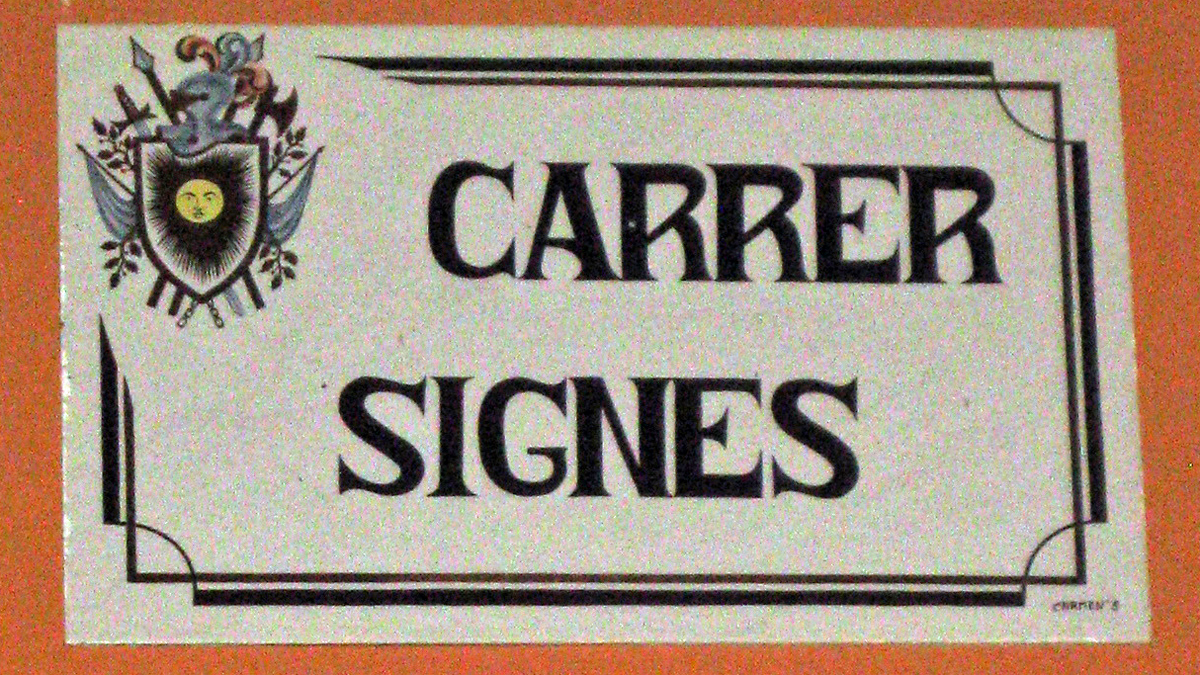
The first time I was ever in Gata was
in 1964 and it was amazing! In the entire town there were two cars
(as well as the tiny Seat [the Spanish-made version of Fiat] I had
rented in Valencia); the whole town seemed to be run by donkey
power. There were only a couple of TVs in town (there was
one shop that had a TV in the window for the public to watch), and
almost no phones (if you were calling from out of town, you could
call one of the ones that existed and try to get the respondent to
go find your party, wherever in town they might be).
In addition, Franco was in power; following his Civil War victory
in 1939 lots of streets throughout Spain were given names in honor
of one of the Fascist leaders of the day; for example the street
on which my father had been born, Calle La Bassa, became Calle
José Antonio, in honor of the founder of the Spanish Falange (the
official name of the Spanish Fascist Party). It's now called
Carrer de la Bassa (Carrer is the Valencian for the Castilian
Spanish Calle, Street).
Signesville. The old Signes Street had also had had its
name changed, to Calle Calvo Sotelo (Calvo Sotelo was a Fascist
leader whose assassination was the trigger for the Spanish Civil
War, kinda like that Archduke dude in 1914). With the return
of a Spanish Republic, Signes Street returned. With the
legalization of the Valencian language outside the home, it got a
new Valencian name, Carrer Signes. Every time I go with a
team I try to get a picture with "my" street on it. When I
came with the Atlantis men in 1995, there was also a Signes
Furniture on the main street and I believe another business with
Signes in the name, and Atlantean and Benidorm 7s MVP that year,
Thaddeus Hill, nicknamed Gata "Signesville" ... I kinda liked
that. And it's not that far off, as Signes is the most common
surname in the town (last I checked, not that many years ago, more
than 20% of the population had either the paternal or maternal
surname Signes). As I recall, when I saw a nationwide telephone
directory in the 90s, more than half of the Signeses in Spain came
from either Gata or a neighboring town.
Spanish surnames include both the father's (first) and mother's
(second), and my first cousin Antonio's official name is Antonio
Signes Signes as both parents were Signes (but unrelated as far as
we know).
In the US, all the Signeses I have been able to find - from New
England to the West Coast - can trace their roots back to Gata,
and I can document that most are related.
Signes in Gata: origin. A few years ago (2007), my
cousin Antonio gave me a history of Gata de Gorgos written in
Valencian. This is just another example of how rural life in
this part of Spain has changed - when I first visited, in the 60s,
it would have been rare to see anything at all written in
Valencian - for one thing it was mostly proscribed -, let alone a
history of a town. The Valencian language, however, has a long
history as a literary language, and some famous medieval books -
perhaps most famously the book of chivalry Tirant Lo Blanc
(1490) - one of Cervantes' influences - were originally written in
Valencian.)
I had thought - based on what my parents knew - that our family in
Gata must have gone back to time unknowable, and as this was an
area ruled by Islam for several centuries, that we may well have
been descended from Muslim residents (and, as Spain was
tricultural for centuries, possibly Jews as well, although most
Spanish Jews were expelled in 1492 by the [in]famous "Catholic
monarchs" Ferdinand and Isabella).
I found out, however, that although Gata appears to have been
almost entirely Muslim, and then Morisco (Morisco = a descendant
of Spanish Muslims theoretically converted to Christianity)
through the early 17th century, all the Moriscos in the Valencia
region (and therefore almost the entire population of Gata!) were
expelled in 1609 (it was part of a nationwide ethnic cleansing
that would go on until at least 1614 *) and that they were
replaced beginning in 1611. The replacement population seems to
have come from Mallorca and Valencia (but may well have originated
in other parts of Spain and likely France as well).
* The
expulsion of the Moriscos is referenced in Don Quixote part II
(1615), where Cervantes shows himself to be sympathetic to their
plight.
Here, from a 1611 document, is part of a list of the first
new residents of Gata as of 1611 (M.DC.XI), including the first
Signes to populate Gata.
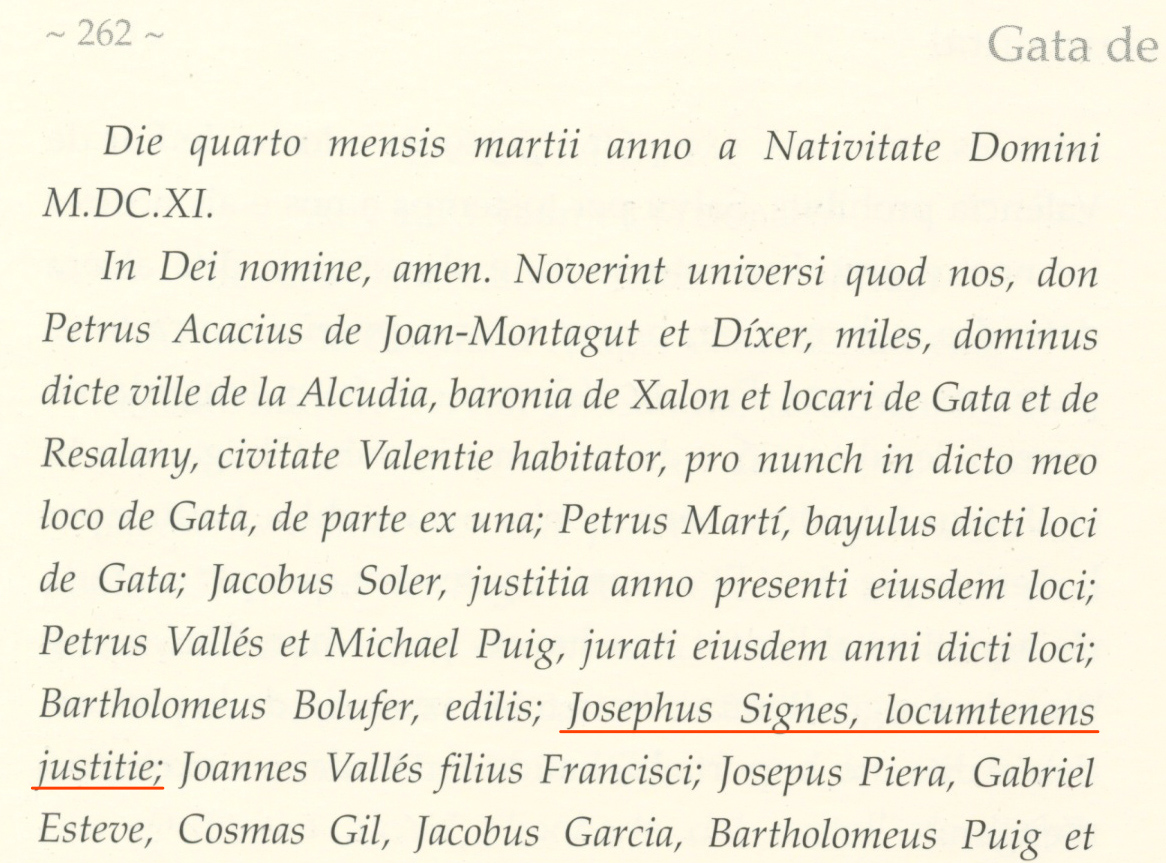 Josephus Signes, "temporary
judge?," was one of the first residents that completely
repopulated Gata in 1611.
Josephus Signes, "temporary
judge?," was one of the first residents that completely
repopulated Gata in 1611.
1611-1st residents of Gata-ul.jpg
And where did the name Signes come
from? Hard to tell, but there is a town "Signes" in
France just across the Mediterranean, near Marseille, and the
path Southern [Mediterranean] France -> Balearic Islands -
> Southeastern [Mediterranean] Spain near Gata is
theoretically a possible emigration path ... did some emigrant
Joseph from Signes, France become - at some point - Joseph
Signes? (Just in case it's relevant, which I doubt, the word
"signes" in Valencian (as well as in French) means
"signs.") Who knows... At best, documentation in small
Spanish towns only goes back to the 16th century, when the
Council of Trent [1540s] decreed, among other things, that all
Catholic parishes should keep a record of births/baptisms,
marriages and deaths).
I've got a lot of experience tracking down ancestors from Catholic
Europe, having done so in the neighboring town of Pedreguer, and
also on my mother's side in both Spain and Italy. In Gata,
however - sadly (and it happened exactly while my parents were
visiting on their honeymoon -> http://emilito.org/family/emilito/signes/1936/1936trip.html),
the Communists (and/or possibly the Anarchists, I'm not sure which
- they both hated the Church - maybe it was just a generic
anti-clerical mob), fueled by class hatred and the start of the
Spanish Civil War, destroyed all the Church records on July
24. This was happening simultaneously in churches all over
Spain. So 400 years of births/baptisms, marriages and deaths, are
lost forever (there are Civil Records, but they only go back to
1871).
I was
able to track down 300 years of ancestors in Pedgreguer because
they didn't burn the records during the Spanish Civil War. They
did, however, kill their priest. In Gata, where they burnt
their records, they left the priest alone. I (secretly and
full of shame) wonder which town's actions created the biggest
long-term loss.
So, while I can conclude that I'm almost certain to be descended
from Josephus Signes (who was - perhaps - a 9th great-grandfather
- maybe 8th, maybe 10th, hard to know), all records between him
and my 3rd great grandfather José Signes (born in the late 18th
century and found via the Civil records) were burnt because of
anti-clerical hatred.
DNA research may give us some information paper doesn't, but only
this burnt paper would have given us the names of our 17th and
18th century ancestors, which DNA can never hope to do.
And just to quickly and briefly
follow up on my parents' Civil War incident: not only were my
parents trapped in Gata when the war broke out, but the fact that
my father was still a citizen of Spain meant he was liable to be
called up to the army and they had to escape. Their
situation clearly caused great distress back home in NJ as noted
in this clip from a local paper - the front pages of issues
recording their disappearance and discovery may be found here: Paterson
Evening News 1936: Signes lost in Spain (and found).
Although the headline mentions Madrid, that was to be my parents'
next destination; they never got there. In fact, they never
got out of Gata until they fled, in a cab, on trains and by foot -
to the French border. They didn't get to Madrid until 1965 and
most people they were to meet there had died in the interim.
(Though Franco was still in power and would be for another 10
years.)
Front page
article in July 24, 1936 Paterson (NJ) Evening News - locals
lost in the Spanish Civil War
1936-0724
headline.jpg / 1936-0724 headshots-800w.jpg /
1936-0724 text-600w.jpg
But back to the Atlantis tour. It's about half an
hour from Benidorm to Gata de Gorgos, and as usual I got excited
the closer we got. We headed straight to the Bar al Pou,
the last building in town. When my grandfather died, my
father inherited this building, and when I got married in Germany,
in order to be able to afford to attend the wedding (both my
parents, both my siblings and my non-Signes [Besteiro] grandmother
came), they sold the house to my father's brother Antonio.
Antonio's son, my cousin Antonio, inherited the house and built
the Bar al Pou, a wonderful bar-restaurant.
Operating the bar tonight and serving us were Antonio, his wife
Maria Rosa Mulet Cervera, her mother Teresa Cervera Molina,
Antonio and María's daughters Rosa and Maite Signes Mulet, and
Maite's husband Juan Lillo.
Before Antonio took over the building it was, as I noted, my
father's, and its main use was as the Gata Signes family's "summer
house" (it was less than a quarter mile from their regular house,
but - for Gata, it was rural compared to "in town"). Once
Antonio took over the house and used it for his business he fixed
it up, both interior and exterior. In addition, as a major well
(Spanish "pozo" but Valencian "pou" - it was called the "Pou de
Pedreguer," where Pedreguer is the town that commences immediately
to the north of the Bar al Pou) was located on their
property (and in dry Spain a well can be a treasure), he called
his place "Bar al Pou" (Bar at the Well).
 Team "at the well": al Pou de
Pedreguer
0529c-es-DSCF0728-the
Pou de Pedreguer-1200w.jpg
Team "at the well": al Pou de
Pedreguer
0529c-es-DSCF0728-the
Pou de Pedreguer-1200w.jpg
Pictures of the house in 1964 (when I first visited) and in 2007
(after Antonio's renovation) are shown below.
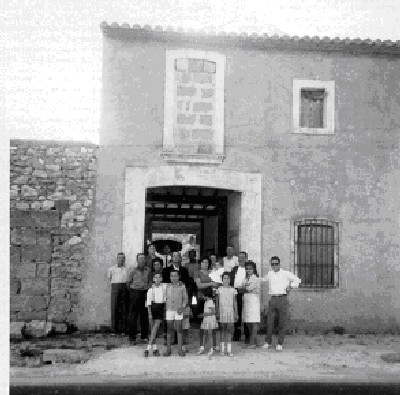
 Bar al Pou building in 1964 and in
2007
1964-pou_de_pedr_1964.jpg / 2007-pou
Signes.JPG
Bar al Pou building in 1964 and in
2007
1964-pou_de_pedr_1964.jpg / 2007-pou
Signes.JPG
The first thing I did, so I wouldn't forget, was get pictures at
the Pou, of a) the team and b) the family. You can see the
"Gata de Gorgos" sign on the building; this building is the very
beginning of town if you are coming from north to south (or the
last one, if coming from the south, which we did).
 The team in front of the Bar al Pou
sign at the entrance to Gata de Gorgos
0529c-cw-DSC_0647-Team
in front of Pou-ed-1205w.jpg
The team in front of the Bar al Pou
sign at the entrance to Gata de Gorgos
0529c-cw-DSC_0647-Team
in front of Pou-ed-1205w.jpg
While we were all saying our hellos, Cynthia walked around the
back of the building and took several pictures. The one
below is a a view from the back showing the Pou and also, on the
left, Montgó, a local mountain that is a landmark of the entire
region. On my first trip to Gata I "climbed" Montgó with the
entire family; my 75-year old uncle got up and down a lot faster
than I, and as opposed to him, I was totally exhausted on our
return.
 View of Montgó from the back of Bar
al Pou
0529c-cw-DSC_0721-Pou
from the back-ed-1200w.jpg
View of Montgó from the back of Bar
al Pou
0529c-cw-DSC_0721-Pou
from the back-ed-1200w.jpg
Three views from our ascent of Montgo so many years ago
follow. On the left is an exhausted Emilito as I approach
the summit. In the second is a family group at the summit;
Antonio, our host tonight, is the boy with the hat in the
middle. The third is a view of Montgó from most of the way
down. I believe this is Antonio's older brother Pepe. That
picture (lower right) is taken looking up the mountain from the
steep face of Montgó.
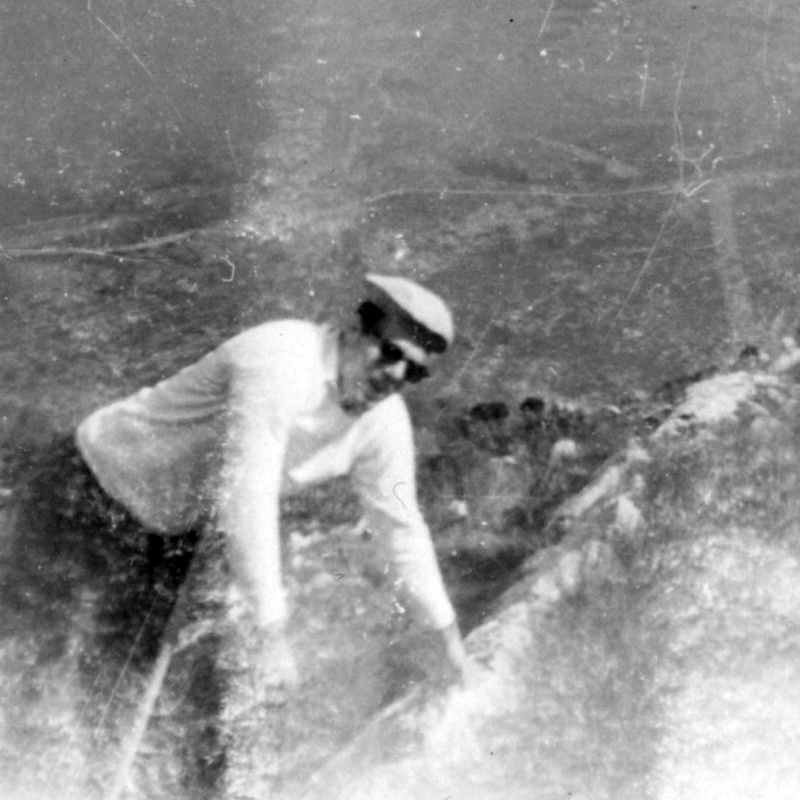
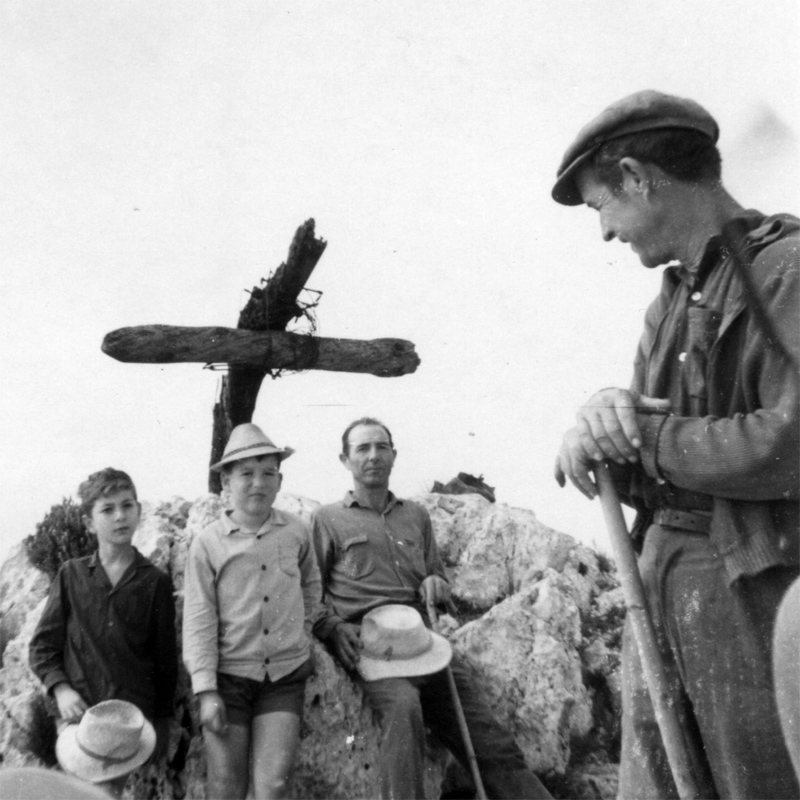
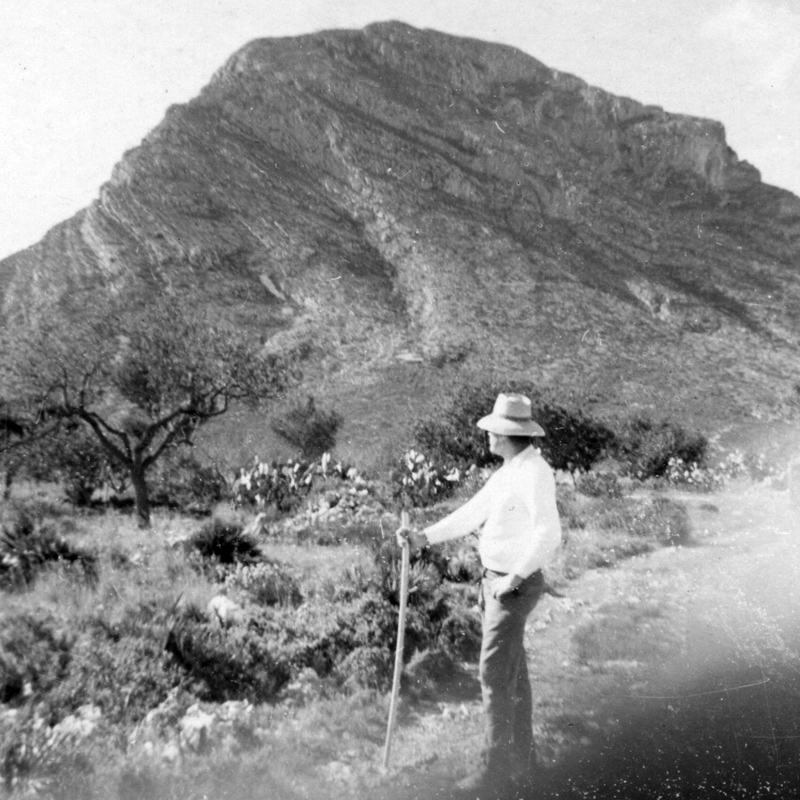 1964: Emilito nears top of Montgó /
Family group at Summit (Antonio in middle with hat)/ Probably
Pepe Signes during the descent
1964-09c
SIGNES Emilito nears top of Montgo-ed-800s.jpg / 1964-09d
SIGNES & PEDRO-Jaime &Antonio&Pepe de Anita &
Vicente @top of Montgo-ed-800s.jpg /1964-09e SIGNES Emilito or
Pepet w Montgo in background-ed-800s.jpg
1964: Emilito nears top of Montgó /
Family group at Summit (Antonio in middle with hat)/ Probably
Pepe Signes during the descent
1964-09c
SIGNES Emilito nears top of Montgo-ed-800s.jpg / 1964-09d
SIGNES & PEDRO-Jaime &Antonio&Pepe de Anita &
Vicente @top of Montgo-ed-800s.jpg /1964-09e SIGNES Emilito or
Pepet w Montgo in background-ed-800s.jpg
But back to Cynthia's photography behind the house. There
are the usual ubiquitous orange trees, and also a really nice
sunset.
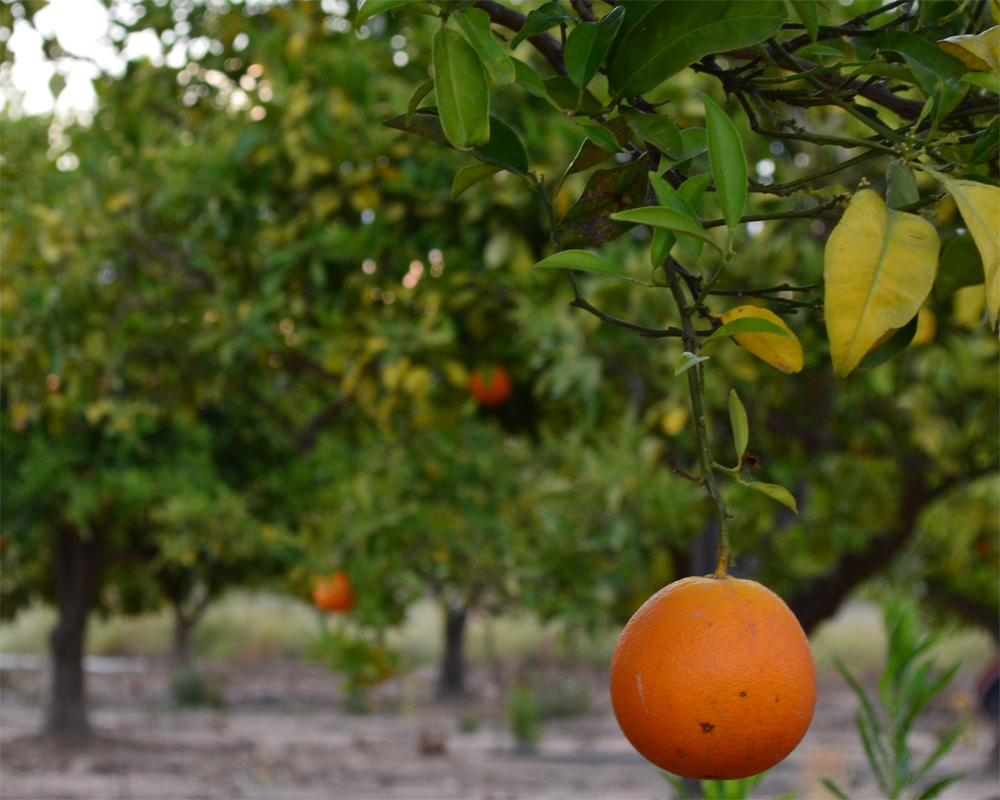
 Left:
Oranges growing behind the Pou // Right: It was a beautiful
evening
0529c-cw-DSC_0728-orange trees-ed-1000w.jpg /
0529c-cw-DSC_0734-sunset-ed-1000w.jpg
Left:
Oranges growing behind the Pou // Right: It was a beautiful
evening
0529c-cw-DSC_0728-orange trees-ed-1000w.jpg /
0529c-cw-DSC_0734-sunset-ed-1000w.jpg
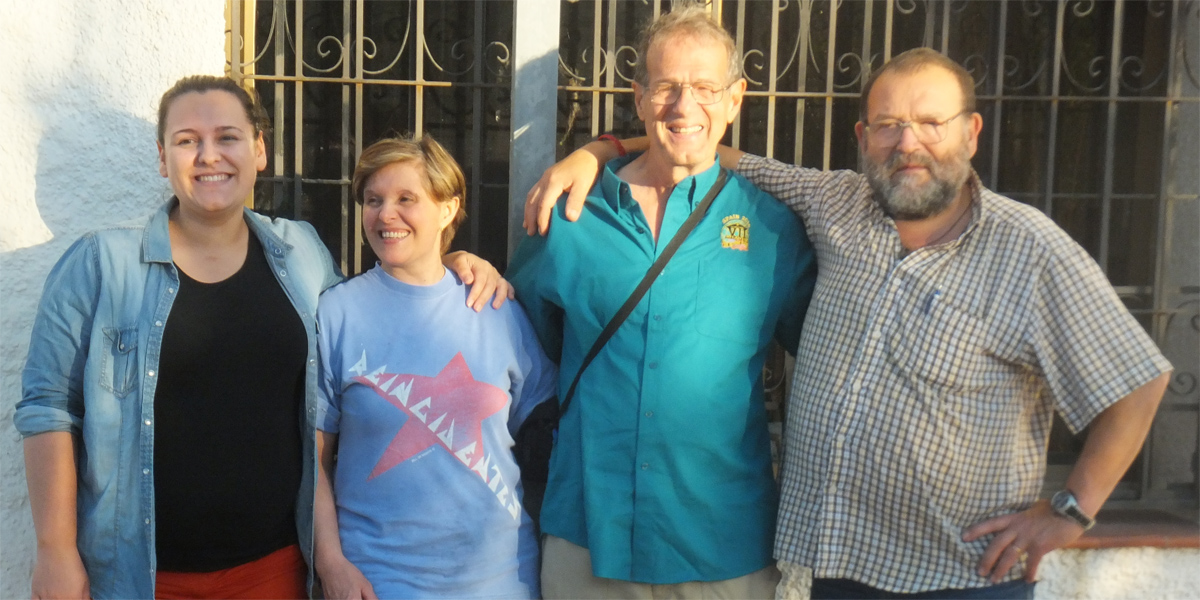 With my cousin Antonio and his wife
María Rosa
On left their daughter María Teresa
(Maite), who tells us she is pregnant with the next Antonio
0529c-es-DSCF0716-Signes
at Pou-1200w.jpg
With my cousin Antonio and his wife
María Rosa
On left their daughter María Teresa
(Maite), who tells us she is pregnant with the next Antonio
0529c-es-DSCF0716-Signes
at Pou-1200w.jpg
The story of our trip to Gata is documented here with pictures far
more than with words.
We presented Antonio with a ball signed by members of the tour
party, and Antonio brought out old balls we had left with him in
the past. I'm pretty sure the stars and stripes balls are
1995 (the year we won) and 1998, the blue ball is from 2006, and
the 4th ball is this year's.
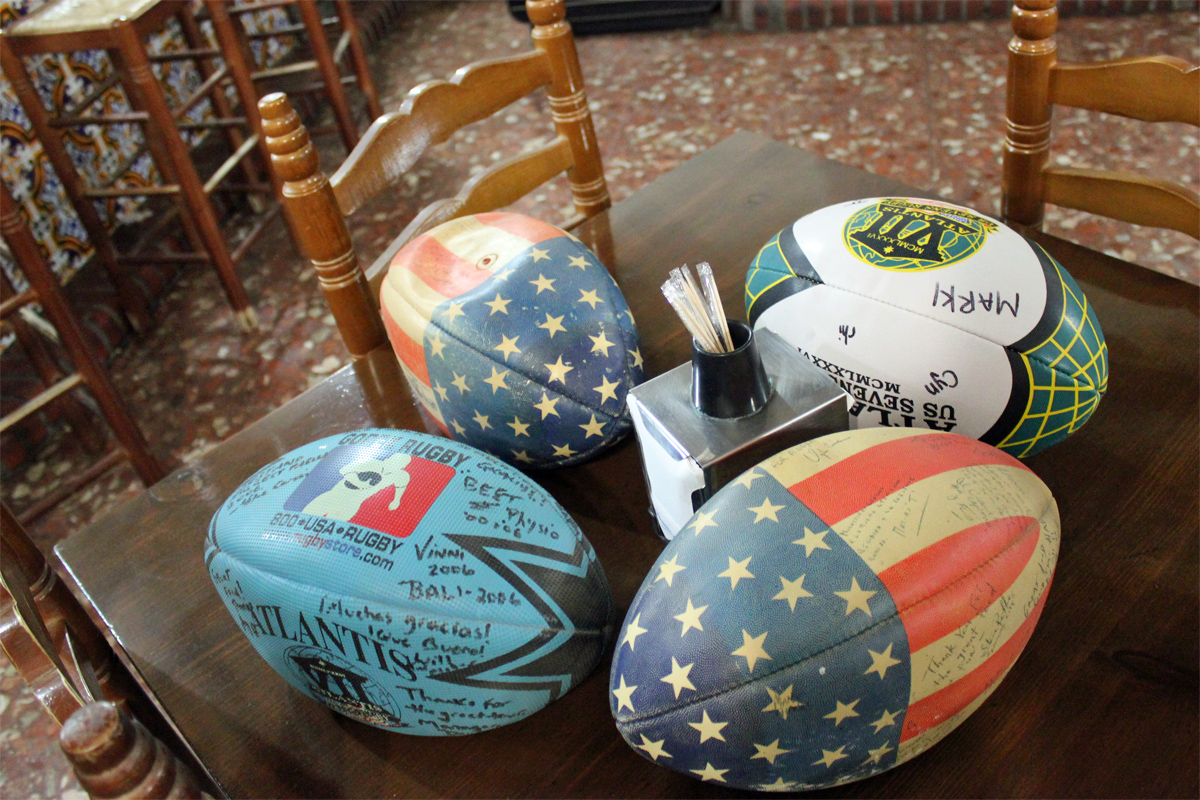 Balls from 4 separate Atlantis
trips.
Balls from 4 separate Atlantis
trips.
Clockwise from right stars and stripes ball, they are from 1998,
2006, 1995 (I think) and 2014
0529d-jz-IMG_6622-old Atlantis
balls-ed-1200w.jpg
My philosophy is that there's always a reason for a team picture:
here's one with the team joined by all the past and present
Atlantis balls in Gata. I am fortunate to be surrounded by
13 women: not only by our entire team (minus the photographer
Cynthia) but the two young Signes women as well.
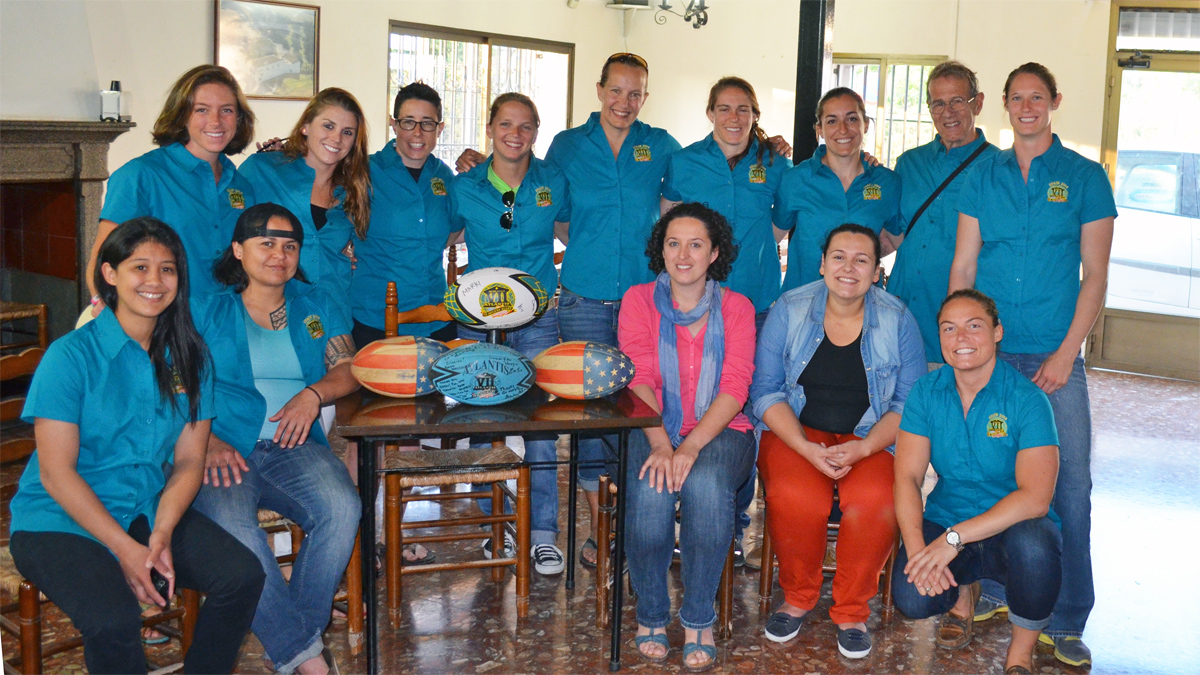 Team, Rosa, Maite, and the four
resident Atlantis balls
0529c-cw-DSC_0708-Team
& previous balls-ed-1200w.jpg
Team, Rosa, Maite, and the four
resident Atlantis balls
0529c-cw-DSC_0708-Team
& previous balls-ed-1200w.jpg
A couple of other pictures taken before dinner was served: girls
in shades and girls in fireplace.
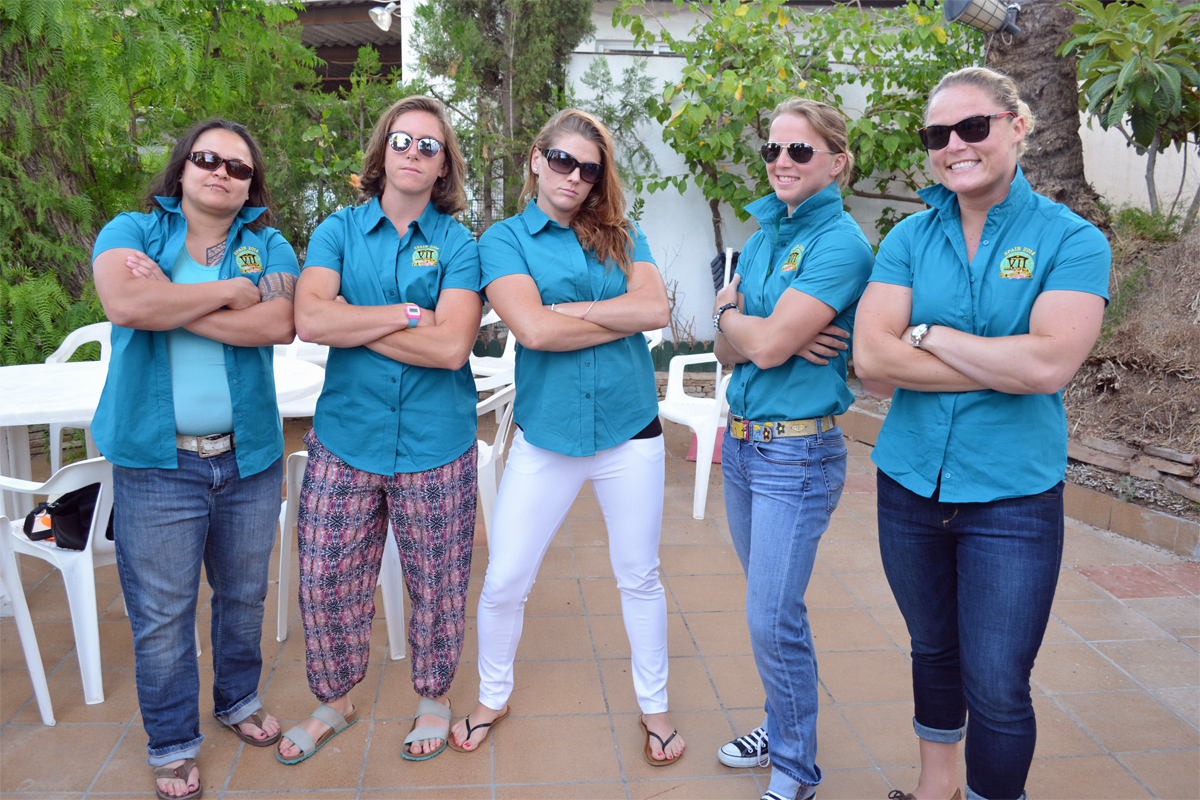
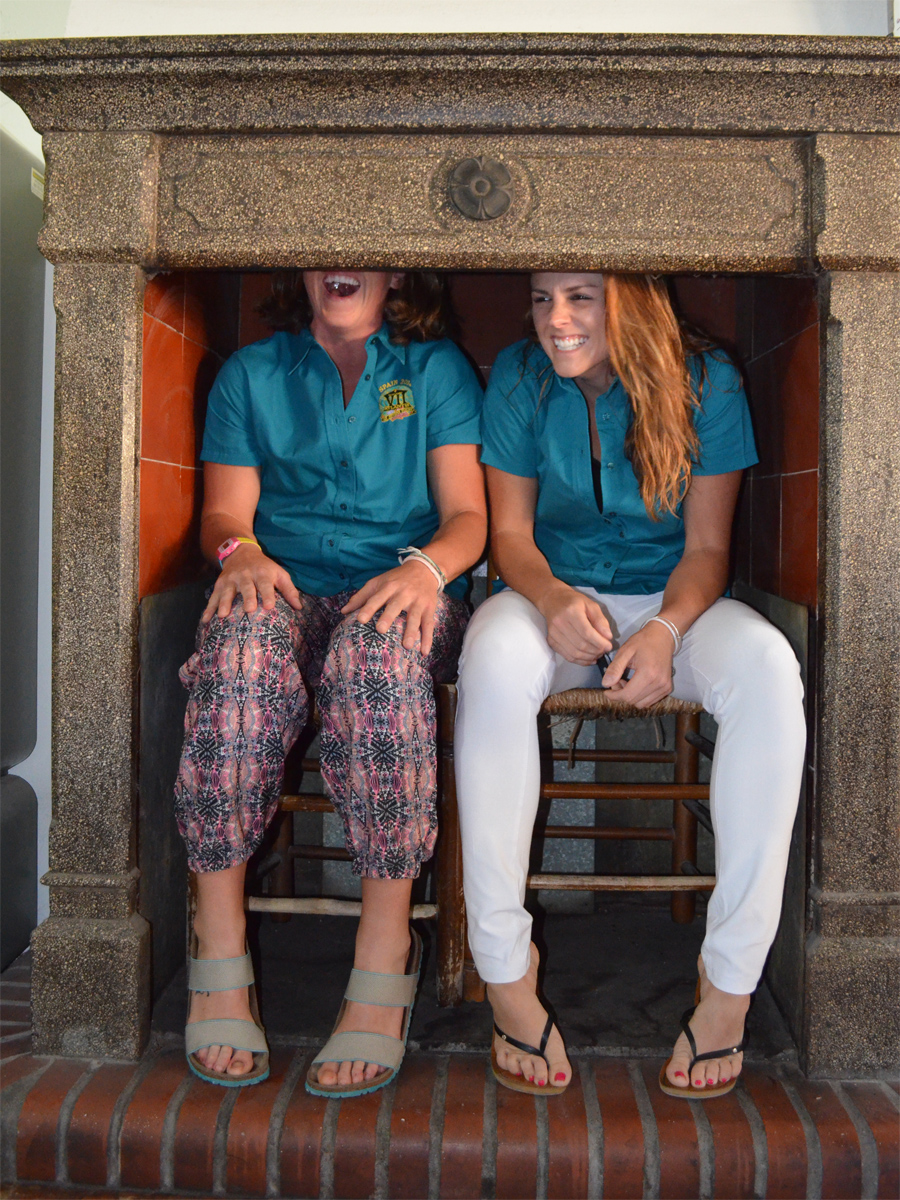 Left: Girls in Shades. Right: Josie
and Mollie find another place to pose
Left: Girls in Shades. Right: Josie
and Mollie find another place to pose
0529c-cw-DSC_0684-JT
Josie Mollie Rhi Cynthia-ed-1200w.jpg /
0529c-cw-DSC_0698-Josie Mollie in fireplace-ed-1200h.jpg
¡Paella!
Sangría and Salad. Our
main course is to be paella, but we start with salad.
As
with most meals, paella can be enhanced by some liquid
refreshment, and Antonio brings some sangría. He warns
that the drinking and driving laws - and punishments - have
become so severe in Spain that the drivers should drink NO
alcohol. As it turned out, warnings
were in order for our driving, but not due to alcohol; we made
sure our drivers didn't drink. A couple of weeks after
returning to the US, however, we received notices of fines due
to speeding as captured by police cameras. Not pleasant ...
And expensive!
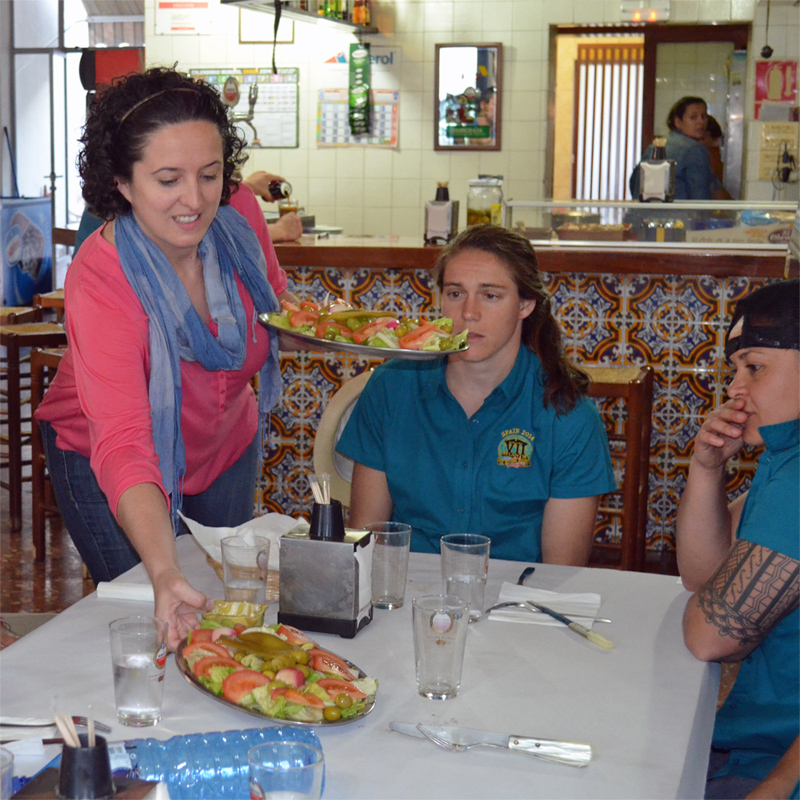
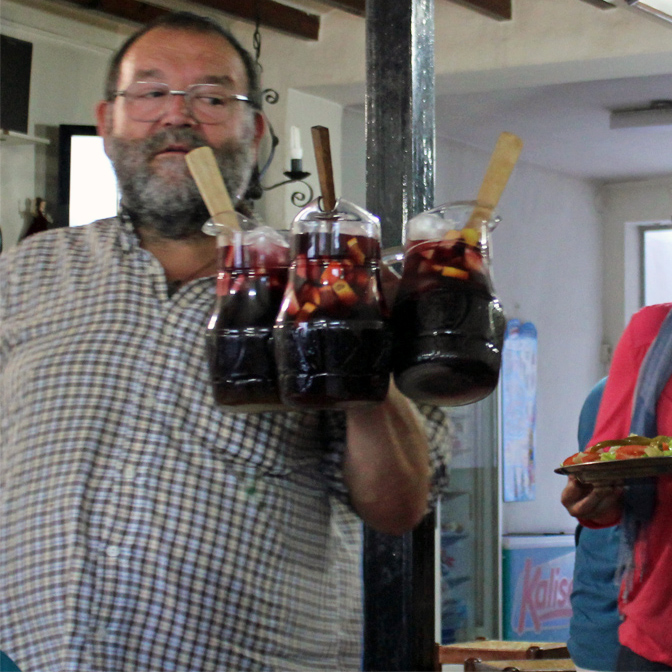 Left: Rosa brings salad / Right:
Antonio brings sangría
Left: Rosa brings salad / Right:
Antonio brings sangría
0529c-cw-DSC_0712-Rosa
brings salad-ed-800s.jpg / 0529c-jz-IMG_6588-Antonio brings
sangria-ed.jpg
Paella. Paella is a regional dish native to the
Valencian region of Spain, and Gata is part of the "Comunidad
Valenciana," one of the 17 autonomous communities that currently
make up Spain.
I grew up on paella (or some
variation thereof: we didn't have a paella pan in Paterson,
New Jersey when I was young, so we made it in pots and just
called it "Spanish rice" or sometimes abbreviated it as "arroz
con pollo," even though ingredient- and taste-wise it did a
good job of imitating paella and had plenty more than chicken
in it. As a child, as long as I can remember, every
Sunday on my way home from church I would stop at Schamach's
drugstore and ask for 25¢ worth of Spanish saffron for the
paella; Lord knows what that little amount would cost
now. I'm not sure why it was the only bit of our weekly
diet that we had to get from a drugstore *, but that's the way
it was.
* I asked this question online of someone that sells saffron
in the US, and he said that, as it was considered an herbal
supplement, in "the old days" it would have been sold in
drugstores, the normal source at the time for these
supplements. But no longer.
I
have had paella (or variations) about a zillion times in
my life, and Antonio's is the best! And his hosting over
the years has been wonderful and caring year after year
after year!
(At home in Paterson, Sunday paella was as a remembrance of my
father's family in Gata, i.e. this house where we're having
paella now. When we had Paterson Sunday dinner, however, at my
maternal grandparents - from Madrid - we had cocido madrileño.
A digression to be sure, but it's here for myself as a
reminder to track down some cocido in Madrid on Atlantis' 2015
visit.)
Without further ado, we are ready to eat, and Antonio's
son-in-law, Maite's husband Juan Lillo Manzanares, brings out the
paella.
We serve ourselves, and ... it's on!
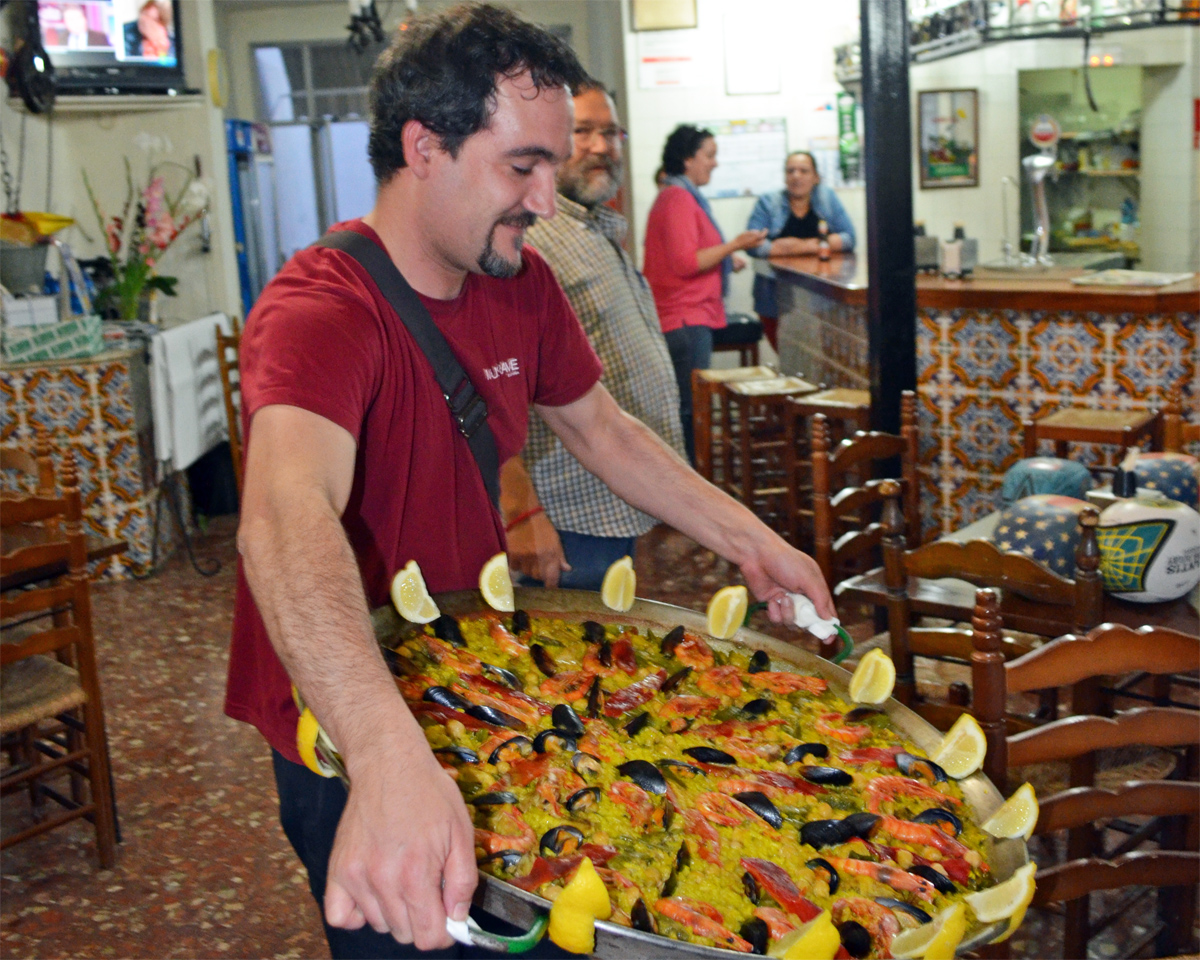 Juan brings out the paella
0529c-cw-DSC_0753-Juan
brings out paella-ed-1200w.jpg
Juan brings out the paella
0529c-cw-DSC_0753-Juan
brings out paella-ed-1200w.jpg
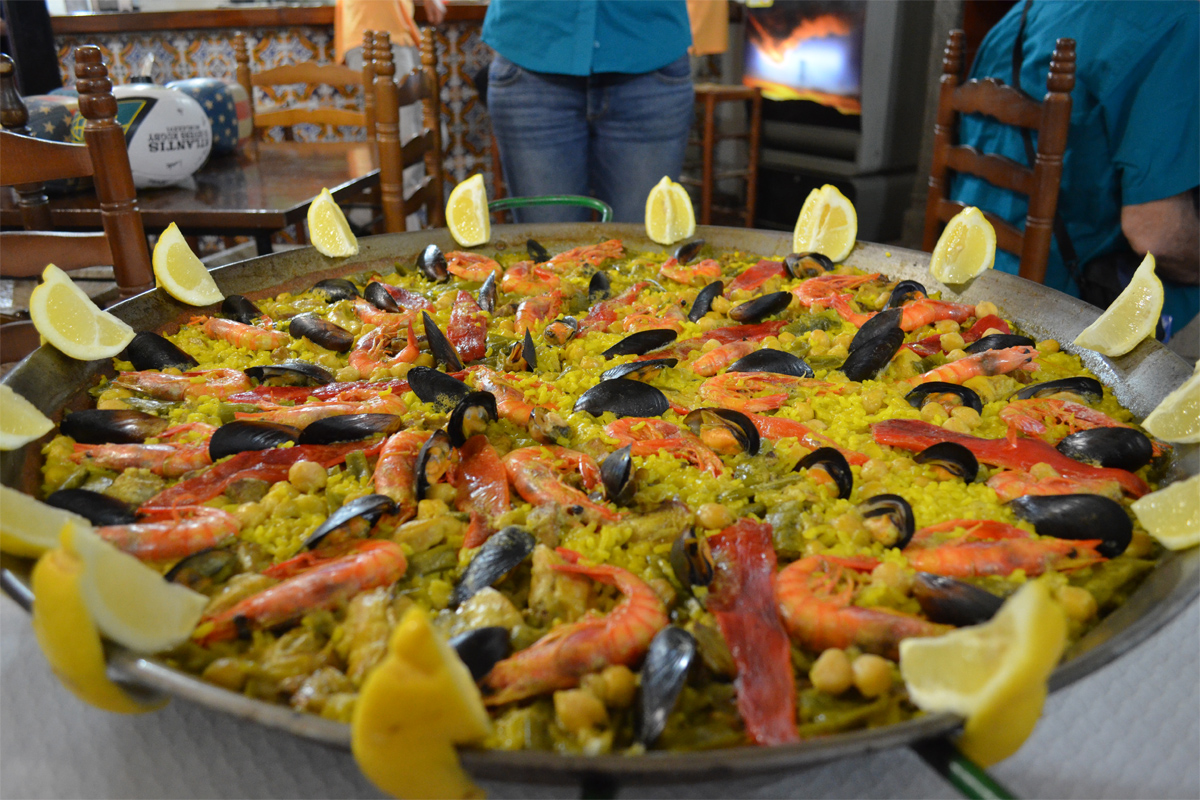
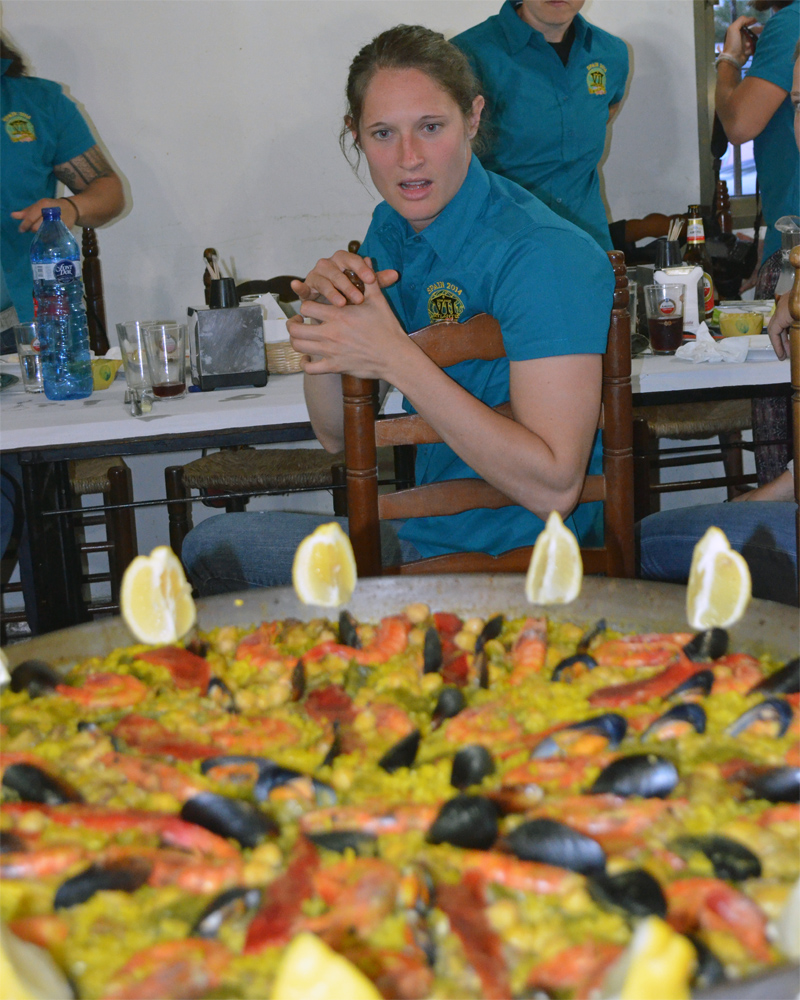 Left: the paella before eating /
Right: Kaelene looks impressed
Left: the paella before eating /
Right: Kaelene looks impressed
0529c-cw-DSC_0757-the paella-ed-1200w.jpg /
0529c-cw-DSC_0759-Kaelene looks impressed-ed-1000h.jpg

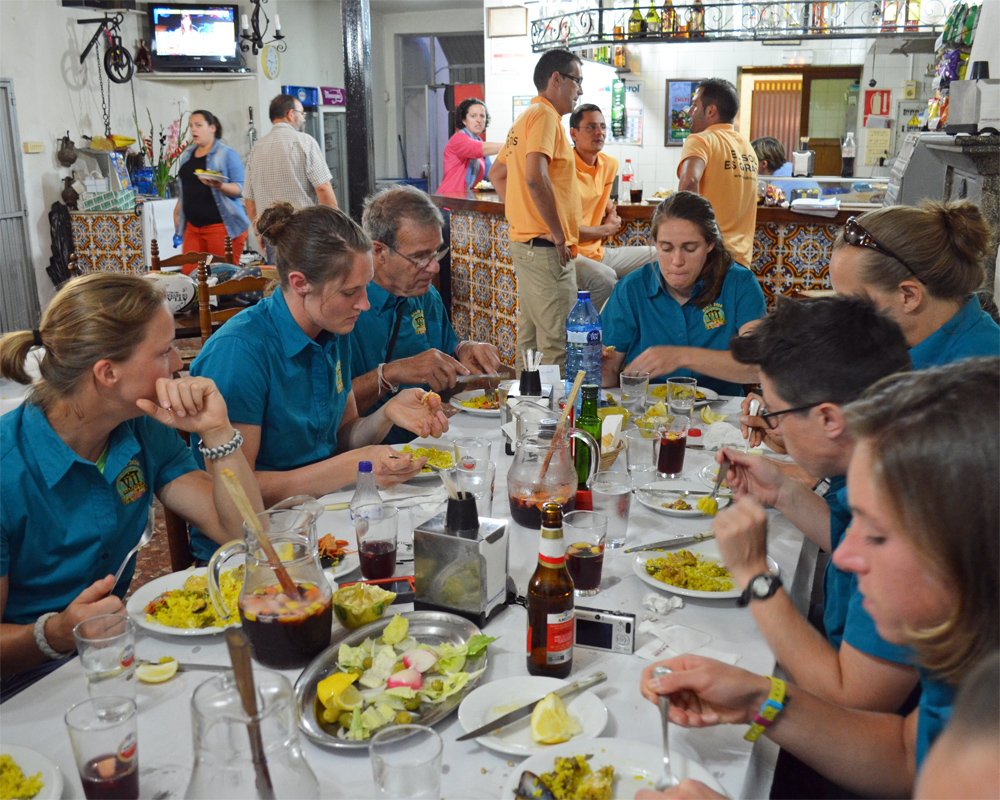 We serve ourselves and get to work
eating (while the family continues to work)
0529c-cw-DSC_0762-digging
in-ed-1000w.jpg / 0529c-cw-DSC_0779-team eats dinner Ant &
family working-ed-1000w.jpg
We serve ourselves and get to work
eating (while the family continues to work)
0529c-cw-DSC_0762-digging
in-ed-1000w.jpg / 0529c-cw-DSC_0779-team eats dinner Ant &
family working-ed-1000w.jpg
Nísperos. Then a fruit that we're not familiar with was put
on the table: nísperos. I had had these before, at
Antonio's, but wasn't able to tell the players what they are in
English - apricots was the closest anyone could get, but they're
not apricots. After my return home, I finally looked up níspero
online and got this description:
"The
nispero, or Japanese loquat in English is an Asian fruit that
has been cultivated for thousands of years. Although
introduced to Spain about two thousand years ago by sailors
arriving in ports of the Valencia region, it wasn't until the
19th century that the loquat began to be cultivated in Spain
and elsewhere around the Mediterranean. The loquat tree
thrives wherever citrus trees do, making the warm coastal
areas of the Mediterranean a perfect fit."
Dear Reader, I have never heard of a "loquat," have you? I
didn't think so. The other (possible) English translation I
found was "medlar," and I've never heard of that either. Here is
the plateful of nísperos that we were served. Yummy.
Nisperos
0529c-cw-DSC_0790-nisperos-ed-1200w.jpg
We thanked the chefs and got in a group picture with the team,
María Rosa, and the person everyone in the family agreed was the
inspiration behind the paella and the only person that knows all
its details and secrets, María's mother Teresa Cervera. Marki then
gives the inspirational chef a big hug.
After I returned home, I asked Rosa for the ingredients of
everything we ate, but to keep any secrets to herself. I got
the following list:
Salad:
lettuce, onion, tomato, olives, pepper, cheese, jamón serrano,
tuna, white asparagus. And of course olive oil and vinegar.
Other appetizers included squid and bread with "all i oli," a
garlic and oil sauce.
Sangría: wine, orange drink, brandy, vermouth, seasonal fruit,
sugar, possibly gin or rum, ice.
Paella: rice, rabbit, chicken, pork cutlet, cuttlefish, mussels,
shrimp, green beans, roasted red pepper, chickpeas, saffron,
food coloring, salt, water ... the only secret, says Rosa, is
the cook.
I have determined that when I return with my wife Heide, hopefully
later this year, we will document the recipe and get Teresa to
give us preparation instructions.
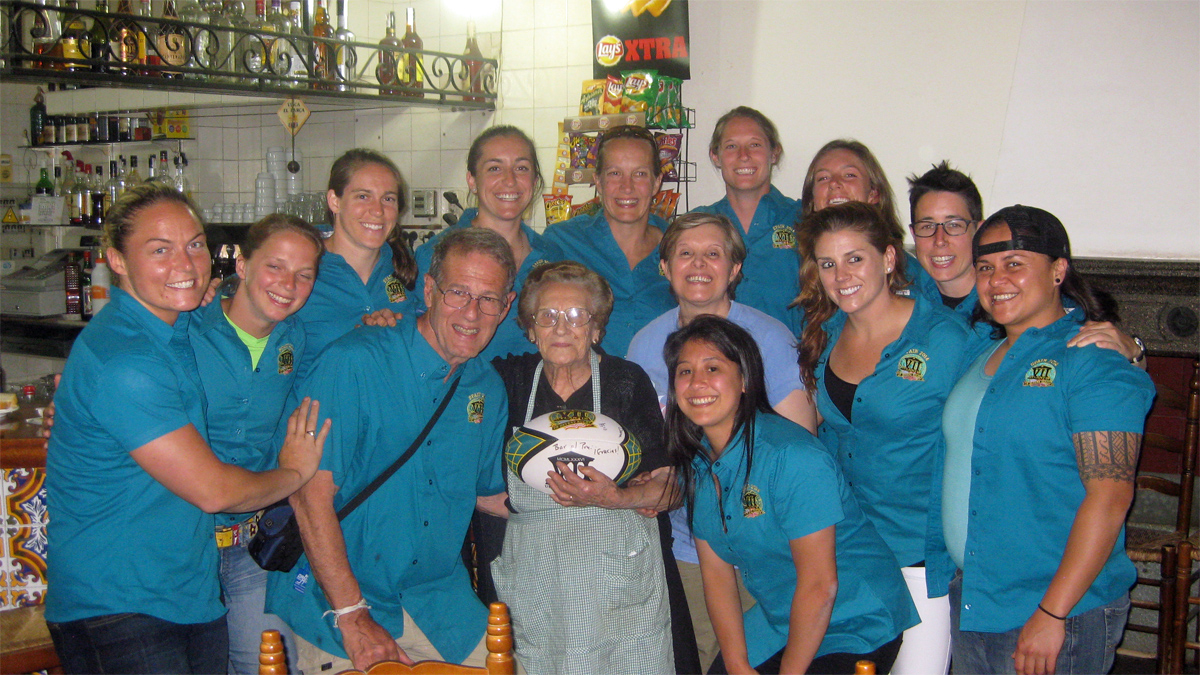
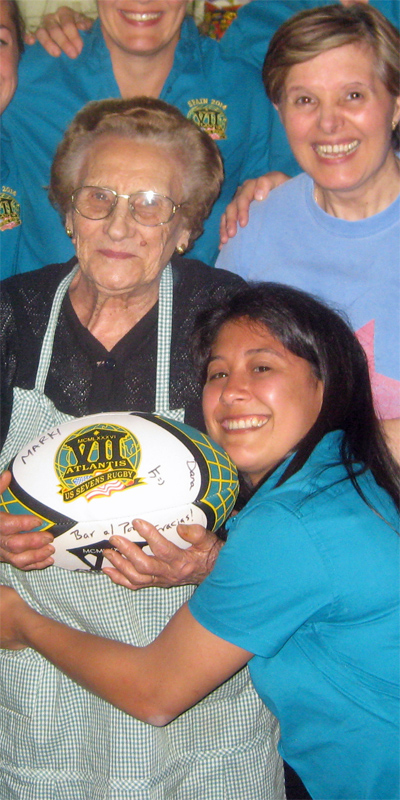 Left. Thanking the chefs: 88-year
old Teresa Cervera Molina, with ball, and her daughter María
Rosa Mulet Cervera.
Left. Thanking the chefs: 88-year
old Teresa Cervera Molina, with ball, and her daughter María
Rosa Mulet Cervera.
Right. Marki thanks Teresa with a big hug
0529c-ew-IMG_0243-everyone with the
chefs-ed-1200w.jpg
0529c-ew-IMG_0242-praising
the chef w Marki-ed-400w.jpg
Wandering through
Gata
With Rosa Signes to guide us, we
were able to wander through a few of Gata's streets. The first
picture, below, shows us walking off the main drag onto a typical
Gata street (Carrer del Dr. Gómez Ferrer). Next we have Rosa
and I stopping in front of Carrer La Bassa 57, the house where my
father and her grandfather were born. I forgot to ask, but the
last time I was in Gata the house remained unoccupied, and it
looked that way still.
In the time of my parents' generation - and when I first visited
there - the wide doors were necessary so the cart, pulled by the
family donkey, could be taken through the door, through the
kitchen (once the table was moved), through the back patio into
his stall (which area was shared with the family outhouse). Thus
the bottom of the door is flush with the sidewalk.

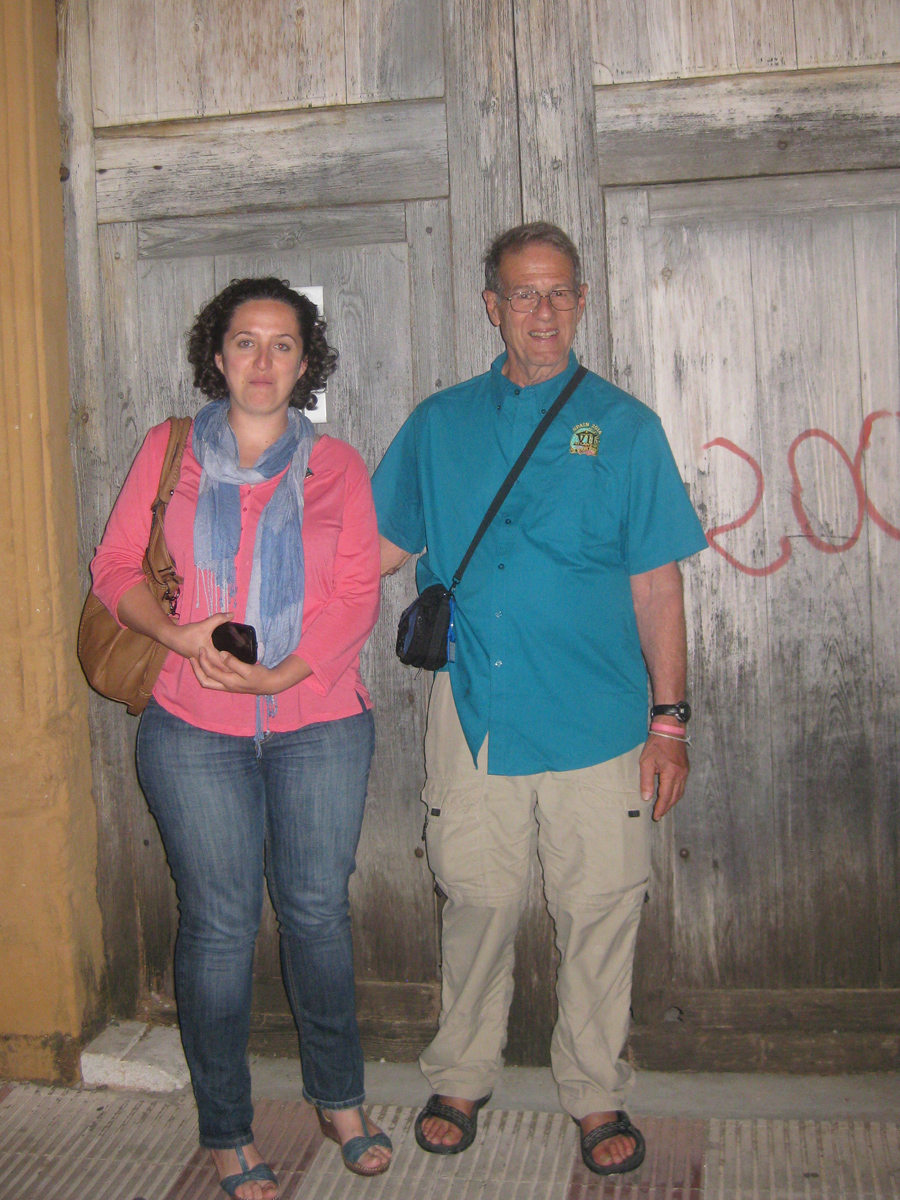 Left: Wandering through Gata /
Right: Rosa & Emilio at her grandfather's, his father's
birthplace
0529d-cw-DSC_0813-wandering
through Gata-ed-900w.jpg / 0529d-ew-IMG_0249-Rosa & Emilio
@ EMS birthplace-ed-900w.jpg
Left: Wandering through Gata /
Right: Rosa & Emilio at her grandfather's, his father's
birthplace
0529d-cw-DSC_0813-wandering
through Gata-ed-900w.jpg / 0529d-ew-IMG_0249-Rosa & Emilio
@ EMS birthplace-ed-900w.jpg
We
passed the church and heard music coming out. We quietly
walked in the side door and heard choir practice. It was
really pleasant and I wish I had recorded it, but of course I
didn't think of it till after the fact. When we were
leaving we realized that Marki had gone in the main entrance to
actually use the church as a church.
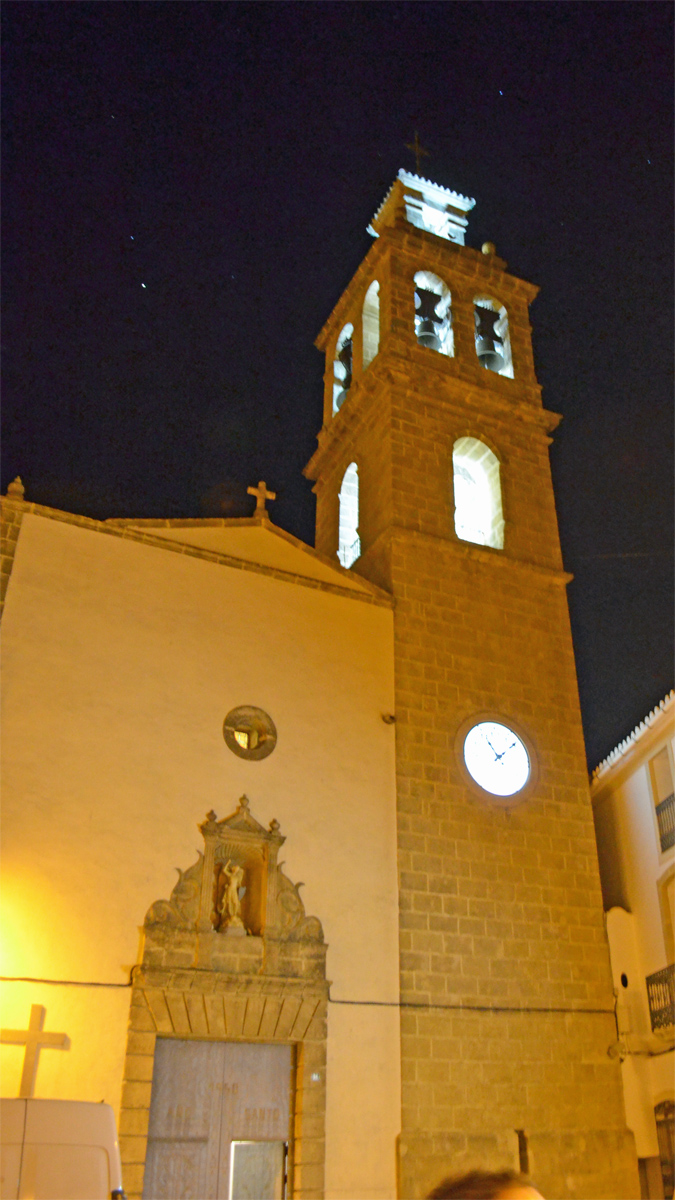
 Left: Church of St. Michael the
Archangel / Right: Marki
in church
0529d-cw-DSC_0807-church-ED-1200h.jpg
/ 0529d-cw-DSC_0808-Marki praying in church-ED-1200h.jpg
Left: Church of St. Michael the
Archangel / Right: Marki
in church
0529d-cw-DSC_0807-church-ED-1200h.jpg
/ 0529d-cw-DSC_0808-Marki praying in church-ED-1200h.jpg
We wandered over the river Gorgos,
for which Gata de Gorgos is named. Only problem is, every
time I've ever been there the Gorgos has been dry, and this trip
was no exception (well there might have been a tiny amount of
water). I'm told that usually once a year, sometime around
mid-autumn, water flows - sometimes rapidly - in the Gorgos.
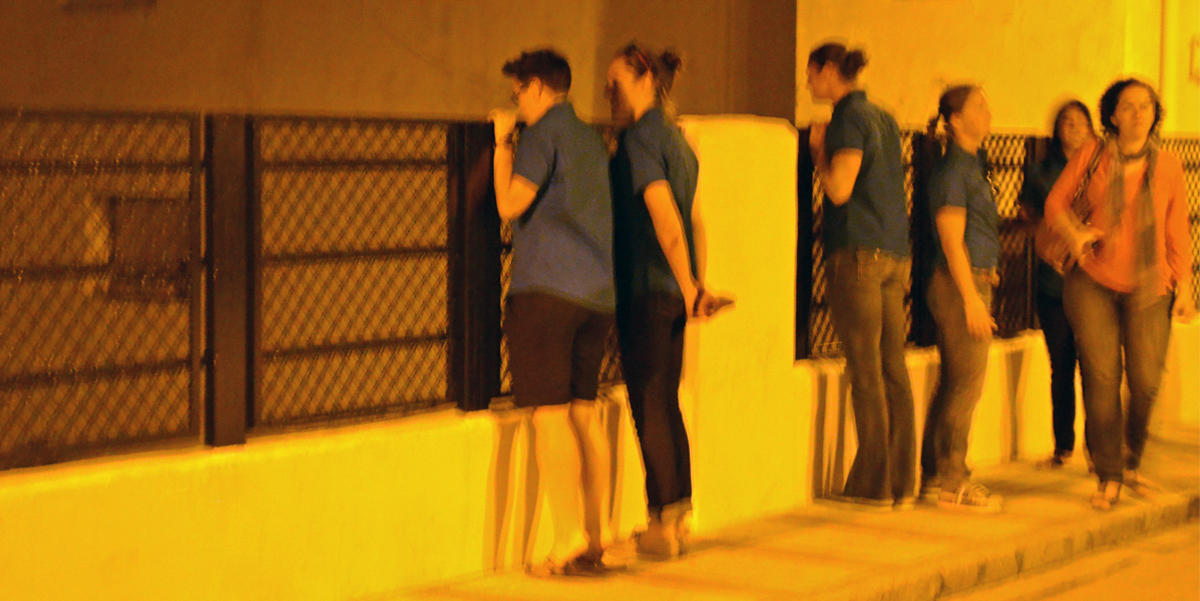
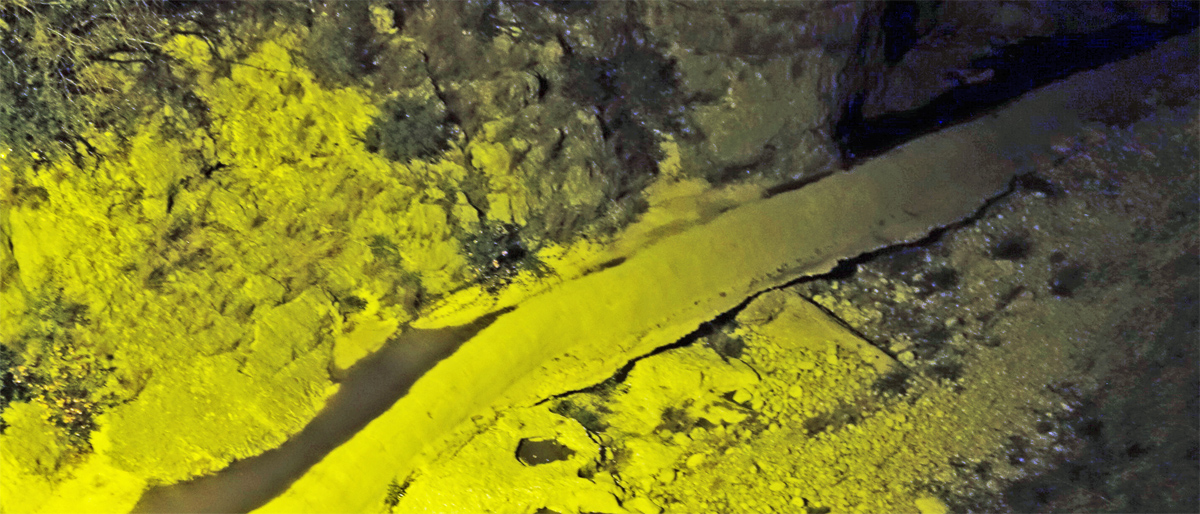 Top picture: the team checks out
the Gorgos / Bottom: the Gorgos is basically dry
0529d-cw-DSC_0809-checking
out the Gorgos-ed-1200w.jpg / 0529d-mm-DSC04386-Rio Gorgos
bed-ed-1200w.jpg
Top picture: the team checks out
the Gorgos / Bottom: the Gorgos is basically dry
0529d-cw-DSC_0809-checking
out the Gorgos-ed-1200w.jpg / 0529d-mm-DSC04386-Rio Gorgos
bed-ed-1200w.jpg
The river was at
the half-way point of our walk, see middle image below. We
started at the Pou, off the map at the top; we went straight
at the fork. That put us on Carrer la Bassa, place of
the Signes ancestors' birth house. We made a left at the end
of Carrer la Bassa; just below and to the left of the curve in
our route is the Church Plaza. We crossed the river and turned
around. The picture on the right is from that location
and shows the cliff down to the river with more city streets
on the other side. Returning (going up) we made a right
onto Carrer Signes to go E-W. We then made a left, walked
around Plaça Nova and then back to the Bar al Pou.
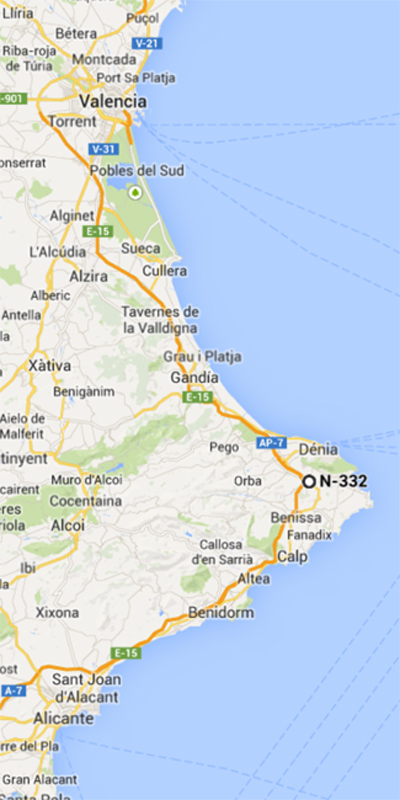
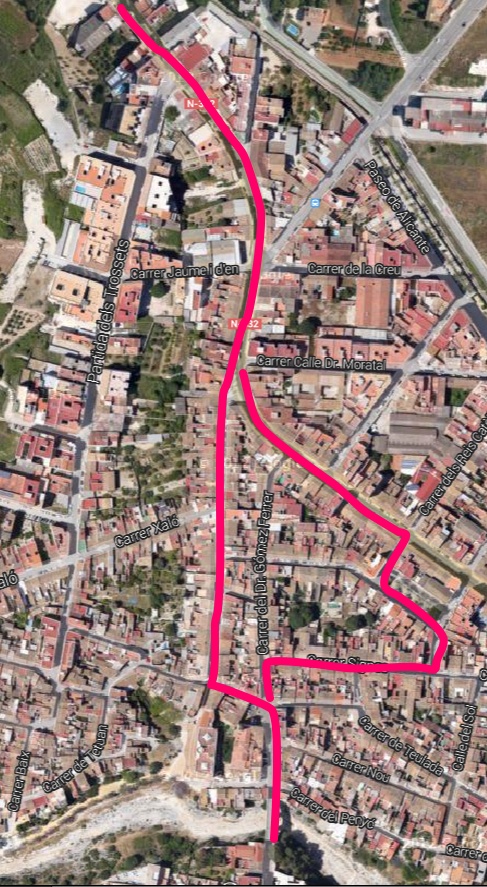
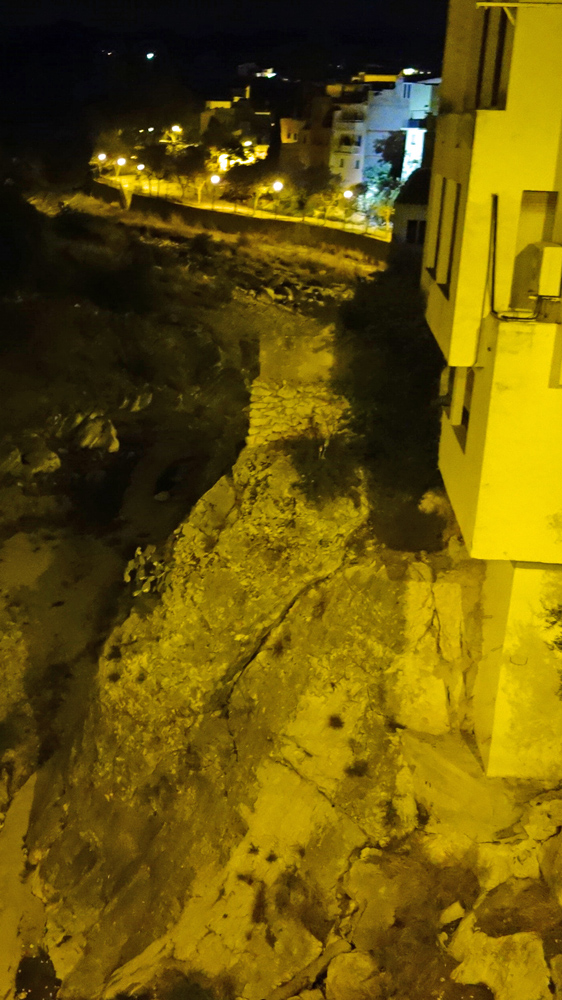 Left: Gata at "N-332" mark /
Valencia at top, Alicante at bottom / Benidorm between Gata and
Alicante
Left: Gata at "N-332" mark /
Valencia at top, Alicante at bottom / Benidorm between Gata and
Alicante
Center: our path, starting off the map at the top, straight to
the bottom, then up, a loop, and back
Right: View from the River Gorgos'
edge (very bottom of route on map)
0529e-gata in
context-800h.jpg / 0529e-walk route.jpg /
0529d-mm-DSC04385-view of cliff-ed-1000h.jpg
As is our tradition, the entire
team was photographed at Carrer Signes (E-W road on the
map). Then we passed by a place I had never particularly
noticed before: Plaça Nova (New Plaza or Square). Dana, however,
the coach of the NOVA (Northern Virginia) Sevens Rugby team,
spotted it very quickly and was happy to be photographed there!
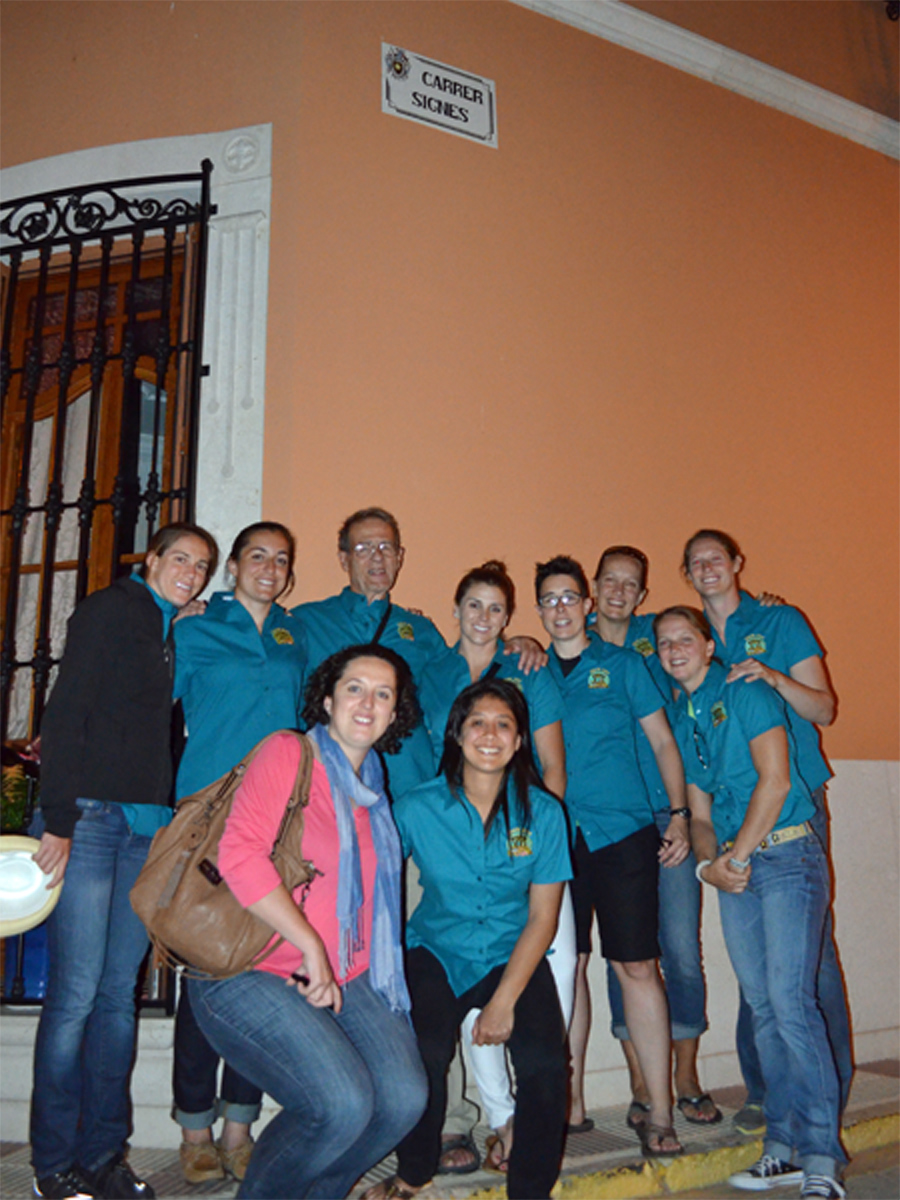
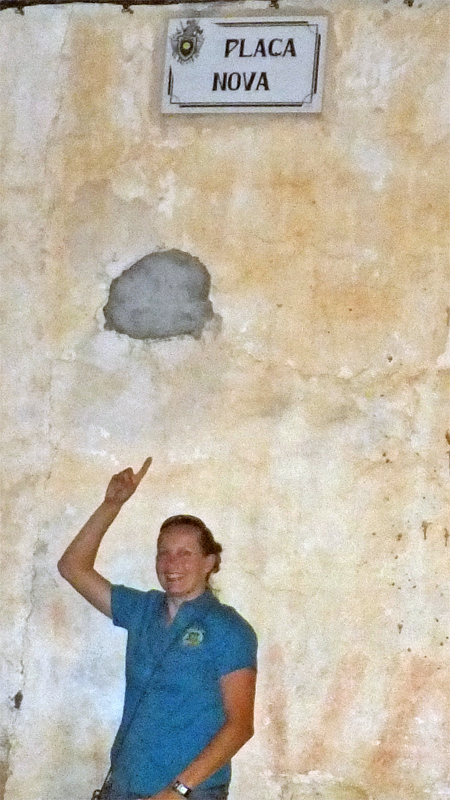 The team at Carrer Signes /
Dana finds Plaça NOVA
The team at Carrer Signes /
Dana finds Plaça NOVA
0529d-cw-DSC_0816-Carrer
Signes-ed-900w.jpg / 0529d-es-DSCF0730-Dana at Plac%CC%A7a
Nova-450w.jpg
We also passed a little play
area where Lunde just had to rock on a playground fixture ... Then
we head back to our cars via Plaça Nova.

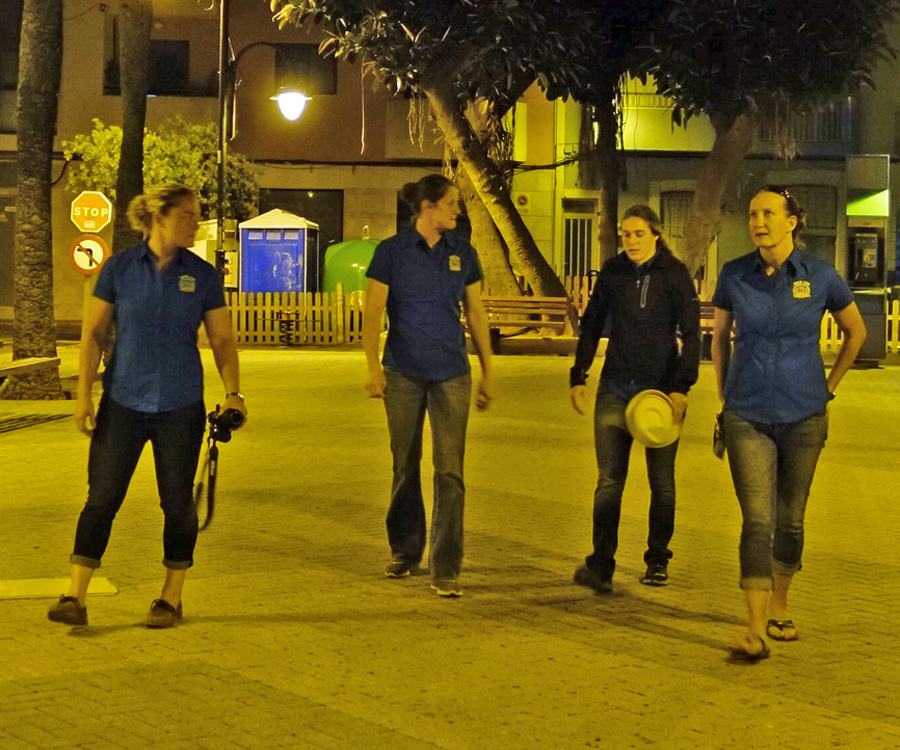 Left: Lunde just had to rock /
Right: Still on the Plaça Nova, slowly heading back to the cars
0529d-mm-DSC04417-Kaelene
rocks at kiddy park-ed-1000h.jpg /
0529d-mm-DSC04418-ed-900w.jpg
Left: Lunde just had to rock /
Right: Still on the Plaça Nova, slowly heading back to the cars
0529d-mm-DSC04417-Kaelene
rocks at kiddy park-ed-1000h.jpg /
0529d-mm-DSC04418-ed-900w.jpg
Finally we headed back to Benidorm. On the way back, the toll
machine couldn't read the inserted card, meaning they couldn't
pay the toll and there were no human beings monitoring any of
the booths, so they had to drive through.
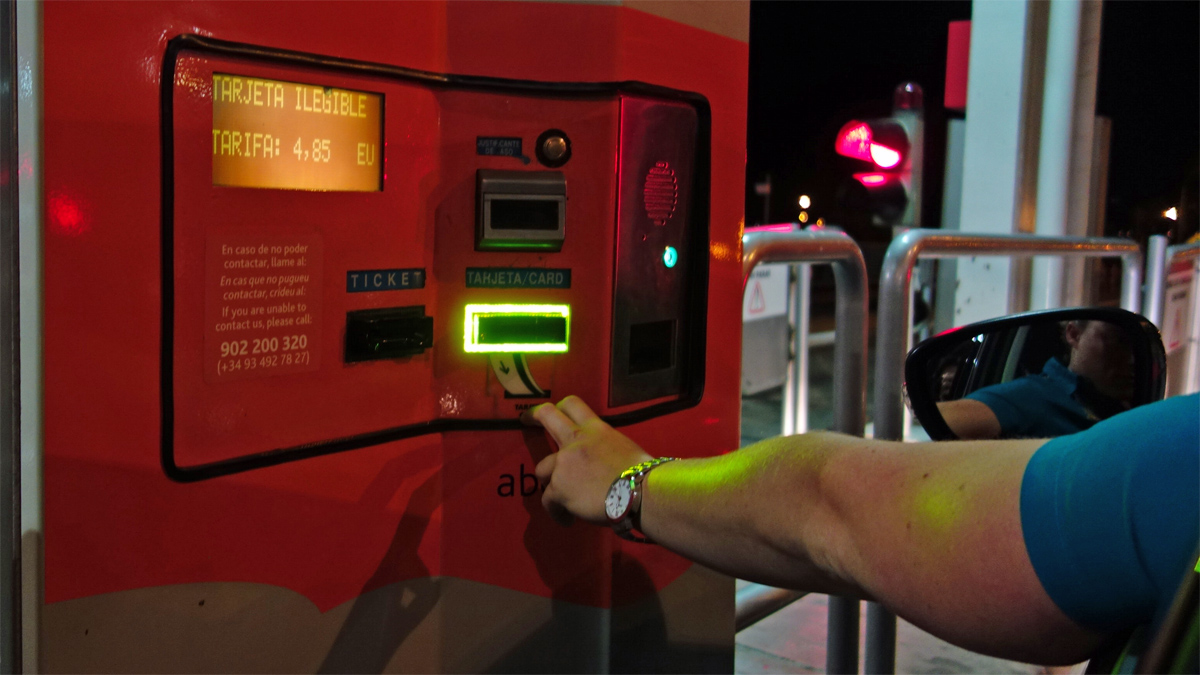 "Card illegible" it says ...
where's help when you need it?
"Card illegible" it says ...
where's help when you need it?
0529d-mm-DSC04443-machine
swallows toll card-ed-1200w.jpg
As of now, we have not heard back if we are to be fined for
this, though we have received a few camera-discovered speeding
tickets through our rental car company. Travelers on
Spain's "autopistas," beware!
Upon our return to Benidorm, I hit the sack; I believe most of the
players hit the town (Benidorm is open all night long).
There was some chatter about a friendly encounter with a
Porsche.
Friday May 30
There were three things we were to
do yet during our stay: get another practice in prior to the
Madrid tournament, get a little go-karting in, and visit Ignacio
and Maike in the beautiful little town of Villajoyosa. After
that we'd be off to Madrid in time for a good night's sleep prior
to the on-field culmination of our tour: Leg 3 of the Madrid
Sevens.
Camp de Joc
"Camp de Joc" is Valencian for
"playing field" ("Campo de Juego" in Castilian Spanish) and the
first place we headed to in the morning - so as not to forget the
reason this particular group came to Spain - was the playing field
at Villajoyosa. By the way, I refer to this town alternately
as "Villajoyosa" (its Spanish name) and "La Vila Joiosa" (or
simply "La Vila") in Valencian. In both languages this means
"The Joyful Town." We parked on the side, so we didn't go through
(or see) the main entrance, so I grabbed this picture from
Atlantis' 1995 (championship) tour to Benidorm.
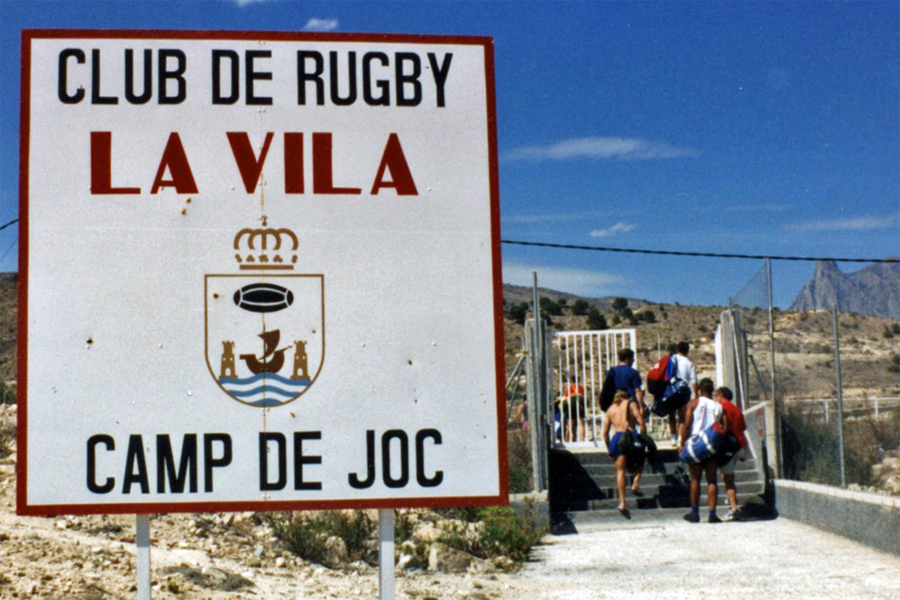 Main Entrance to La Vila's playing
field. Atlantis entering to practice in 1995
1995-05 Camp
de Joc-900w.jpg
Main Entrance to La Vila's playing
field. Atlantis entering to practice in 1995
1995-05 Camp
de Joc-900w.jpg
A couple of views of the La Vila grounds: on the periphery and the
field level with the mountainous background.

 Top: Fieldhouse and changing rooms
inside; stands above / Bottom: the field and background.
0530a-mm-DSC04727-in
the grounds of La Vila field-ed-1200w.jpg /
0530a-mm-DSC04733-the La Vila field-3-ed-1200w.jpg
Top: Fieldhouse and changing rooms
inside; stands above / Bottom: the field and background.
0530a-mm-DSC04727-in
the grounds of La Vila field-ed-1200w.jpg /
0530a-mm-DSC04733-the La Vila field-3-ed-1200w.jpg
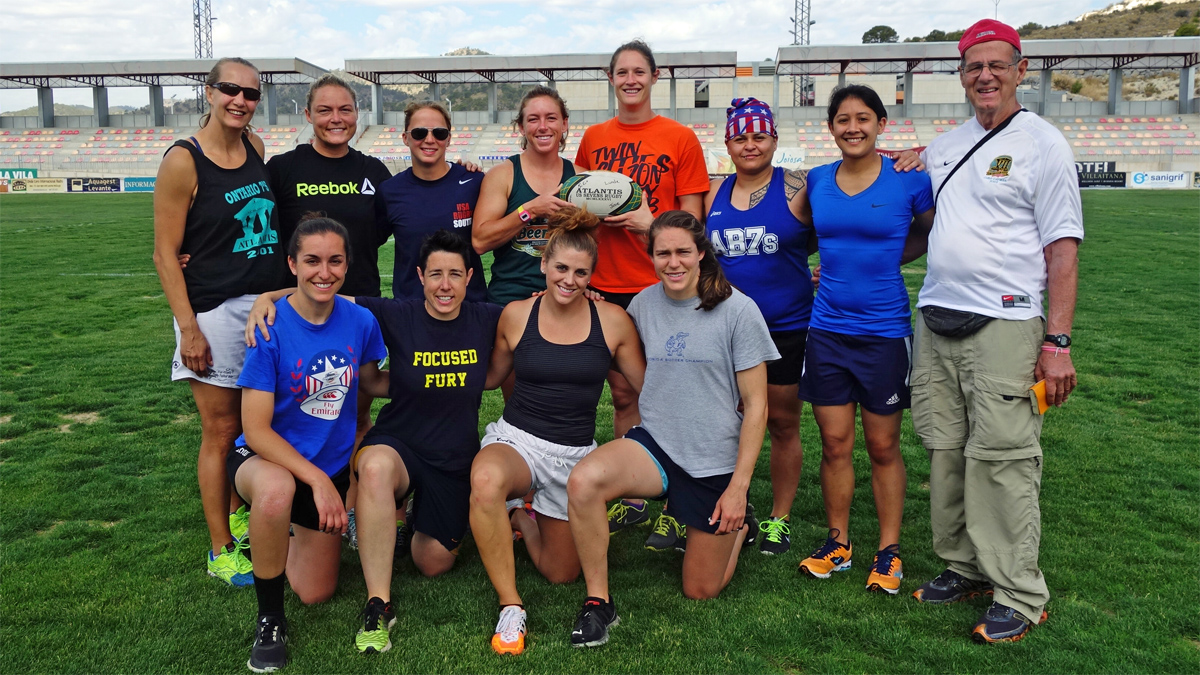 Atlantis following our practice at
the La Vila Camp de Joc
0530a-mm-DSC04737-team
at La Vila field-ed-1200w.jpg
Atlantis following our practice at
the La Vila Camp de Joc
0530a-mm-DSC04737-team
at La Vila field-ed-1200w.jpg
Karting
Finestrat Karting. One of my
favorite attractions of all in Benidorm is Go Karting. This
is not wimpy Go Karting like most tracks in the US, but nice long
windy tracks in tiny vehicles that can exceed 50 mph. There
is more than one venue in the Benidorm area; of late - as we did
again this year - we've been going to the track at Finestrat.
It's pretty expensive, I believe 30€ (about $40) for 10 minutes,
and it was near the end of our tour, so those needing to cut back
on expenses gave it a miss, but I'd give up a couple of meals to
do this.
Six of us went on the track and raced around. .

 Left: another view of Puig Campana
mountain over the Karting / Right: Overview of the Karting track
Left: another view of Puig Campana
mountain over the Karting / Right: Overview of the Karting track
0530b-jz-IMG_6664-Benidorm
hole from Karting-800h.jpg /
0530b-jz-IMG_6644-overview-ed-800h.jpg
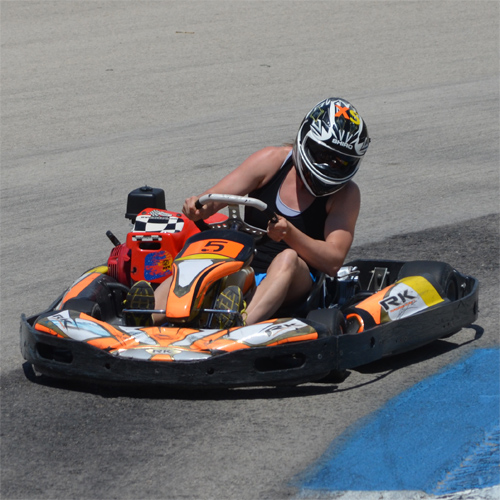

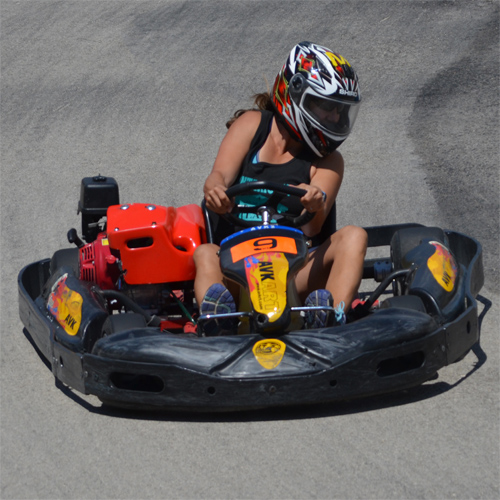
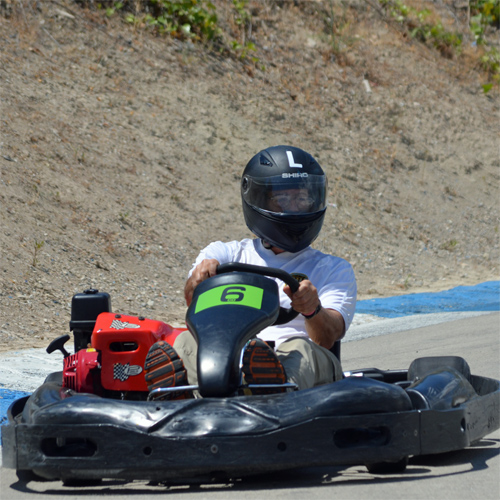 Four drivers on track, L to R:
Kaelene, Mollie, Dana, Emil
Four drivers on track, L to R:
Kaelene, Mollie, Dana, Emil
0530b-cw-DSC_0931-Kaelene-ed-500s.jpg /
0530b-cw-DSC_0982-Mollie at end-ed-500s.jpg /
0530b-cw-DSC_0930-Dana-ed-500s.jpg / 0530b-cw-DSC_0996-Emil at
finish-ed-500s.jpg
I'm
always one of the slowest at these events, partly due to being
orders of magnitude older than everyone else, and collisions are
my only hope - they slow everyone down. There wasn't too
much "mano a mano" driving, unfortunately, here: separation
among us was established pretty early, and I wasn't able to give
anyone a shot as they came by :( ... But it was still fun.
In the picture below, however, it does look like Jess is looking
to cut off Eli coming around this curve.
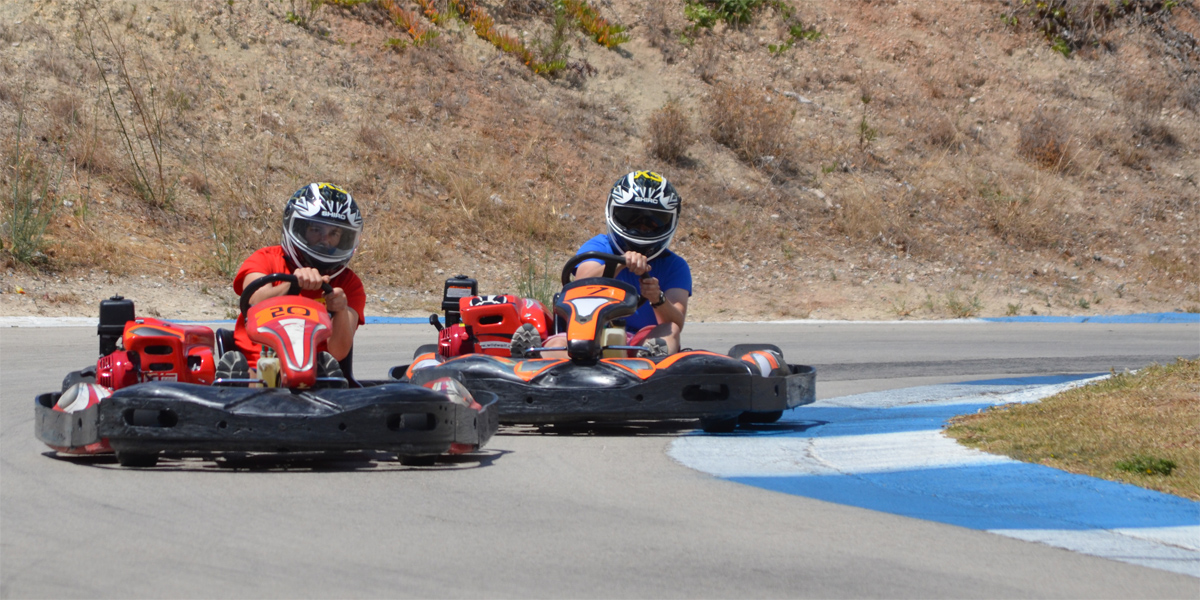 Part way through this curve, Jess
seems prepared to cut Eli off.
0530b-cw-DSC_0952-Jess
cuts off Eli-ed-1200w.jpg
Part way through this curve, Jess
seems prepared to cut Eli off.
0530b-cw-DSC_0952-Jess
cuts off Eli-ed-1200w.jpg
The six racers get together at the end of the ride for a couple of
group photos.
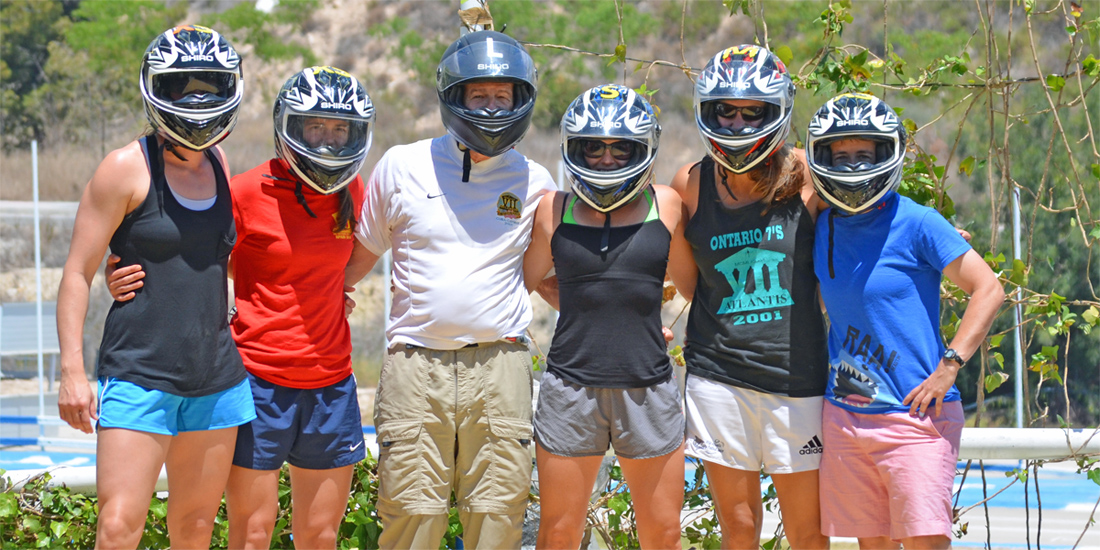
 The 6 racers, masked and unmasked.
Below: Eli, Mollie, Emil, Dana, Jess, Kaelene
The 6 racers, masked and unmasked.
Below: Eli, Mollie, Emil, Dana, Jess, Kaelene
0530b-cw-DSC_1001-6 after race-ed-1100w.jpg /
0530b-mm-DSC04752-Karters-ed-1100w.jpg
A Meal in La Vila
If I haven't mentioned this before,
"lunch" as we think of it is really a misnomer for the Spanish
mid-day meal (la comida). The traditional practice in
Spain is to have a work day broken up by a long, sometimes as
much as 3-hour, break. So a working day may be 9 AM to 2
PM, 5 PM to 8 PM with a three-hour break. The 2 to 5 PM period
comprises the main meal of the day, TV news (the entire time is
filled with the main news programs on television), and possibly
a brief siesta. Historically it goes back to the days when
most people toiled in the fields and it was just too hot to work
through the mid-day sun. The evening meal, "la cena," is
typically much lighter.
Our huge evening paella meals in Gata over the years have been
due to our being available at that time of day rather than to
Spanish custom. So we went from huge evening meal Thursday to
huge mid-day meal Friday.
I knew from my youth that in the area of my father's hometown
they don't speak Spanish as a first language: they speak
Valencian, a language very similar to Catalán (the language of
Barcelona) and Mallorquín (Mallorca), but it didn't hit home
until my first trip there all the implications. At the time I
was trying to relearn Spanish and all of a sudden I had to try
to figure out Valencian; geez ...
When I first visited Gata, I also found out that Franco had
banned the use of the Valencian (and other indigenous
non-Castilian) languages (other than in the home, I suppose);
they were not to be used in schools, in any official written
documents (not that most working-class Valencians could write in
Valencian anyway), etc.
In fact, the first time I was in Spain, my older family
members spoke a Valencian-laced Spanish, as - despite all
the laws - all they'd spoken all their lives was Valencian, and
most left school - as did my father, who was a laborer all his
life - at 8 years old to work in the fields. Rosa notes
that even her father and most people of his generation had to
leave school early - as children - to work the fields or
factories.
Now, however, it seems as though just about all people of all
ages in the region are equally comfortable in both Spanish and
Valencian. And for the most part they stay in school long
enough to become not only bilingual but trilingual: all students
in Gata must learn both Spanish and Valencian and most learn a
third language, e.g. English, as well. Street signs are
also dual language (Villajoyosa and La Vila Joiosa both on the
same sign); this is typical throughout Spain, thus in the Basque
country signs are in Basque and Castilian Spanish, etc.
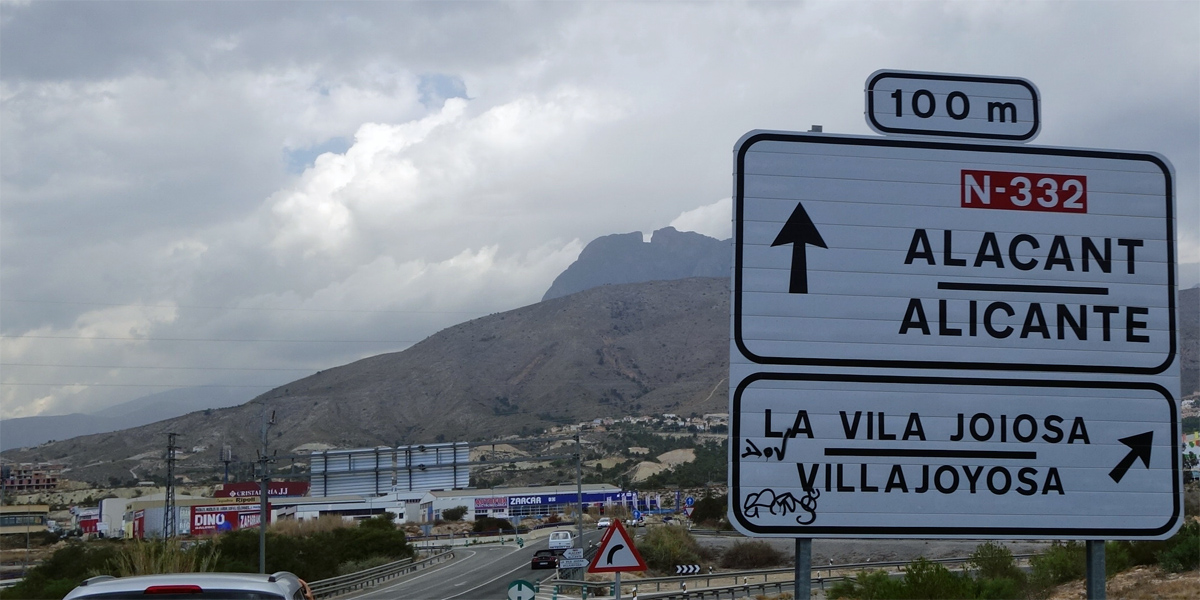 Dual-language
(Valencian and Castilian Spanish) sign.
0530c-mm-DSC04793-to La Vila sign-ed-1200w.jpg
Dual-language
(Valencian and Castilian Spanish) sign.
0530c-mm-DSC04793-to La Vila sign-ed-1200w.jpg
La Vila is known for its attractive downtown, with buildings all
in a row with beautifully painted façades. And it has a
great beach and busy beachfront.
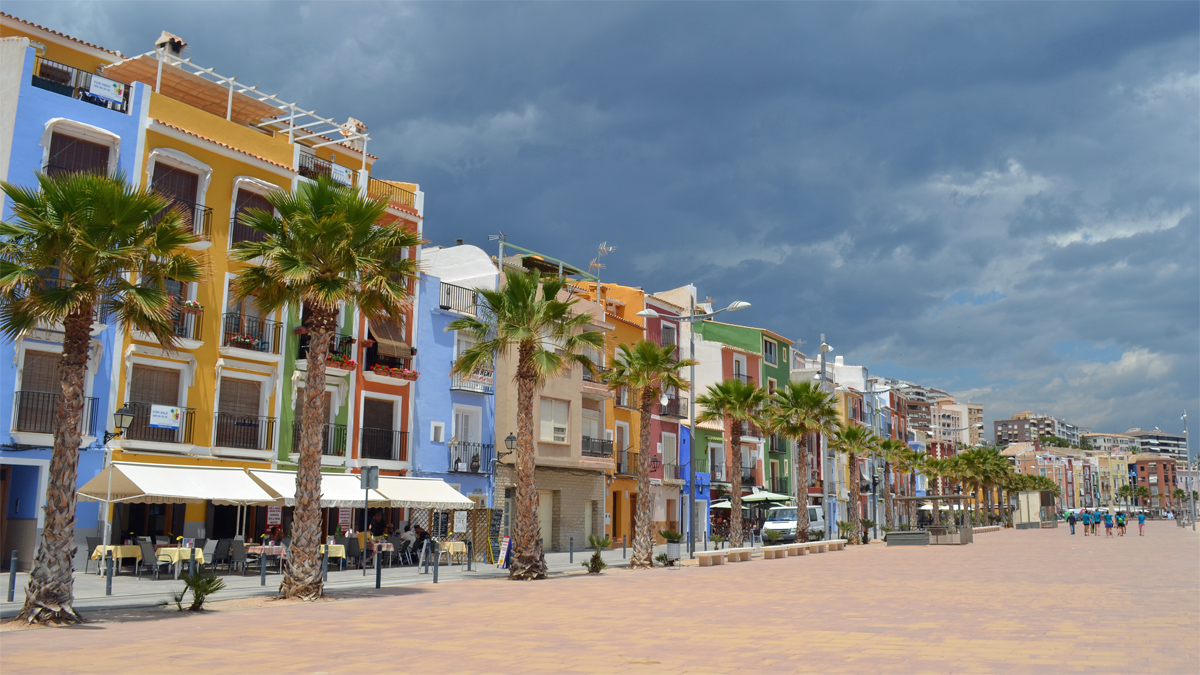
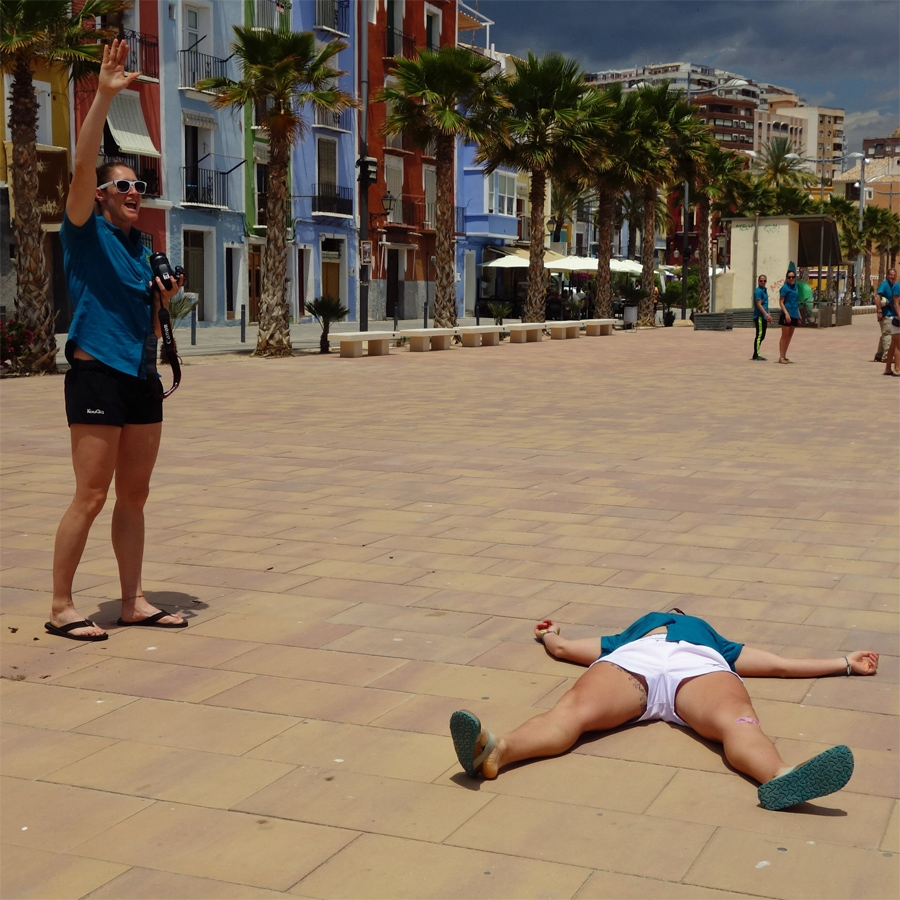
Left: The beachfront street from the beachfront / Right: one of
many "murder game" victims
0530c-cw-DSC_1029-La Vila houses from
beach-ed-1200w.jpg / 0530c-mm-DSC04840-a death-ed-900s.jpg
Ignacio and his wife Maike invited us to a "comida" (main meal)
with them at El Guitarra, a wonderful beachfront
restaurant.
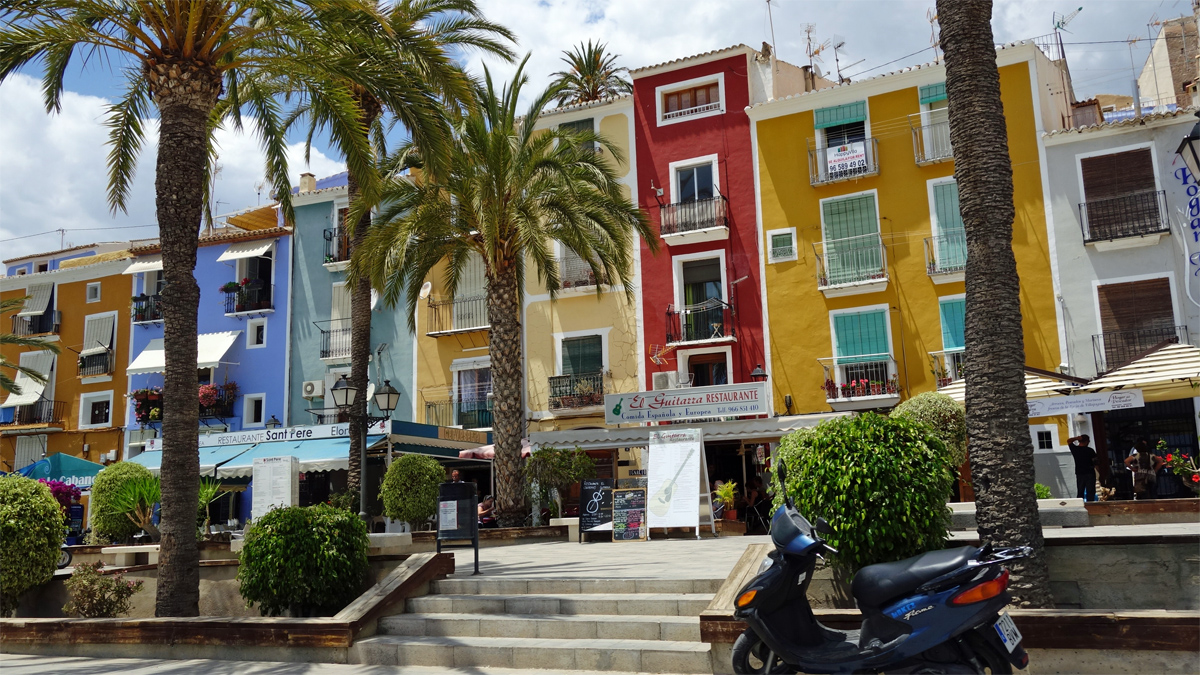
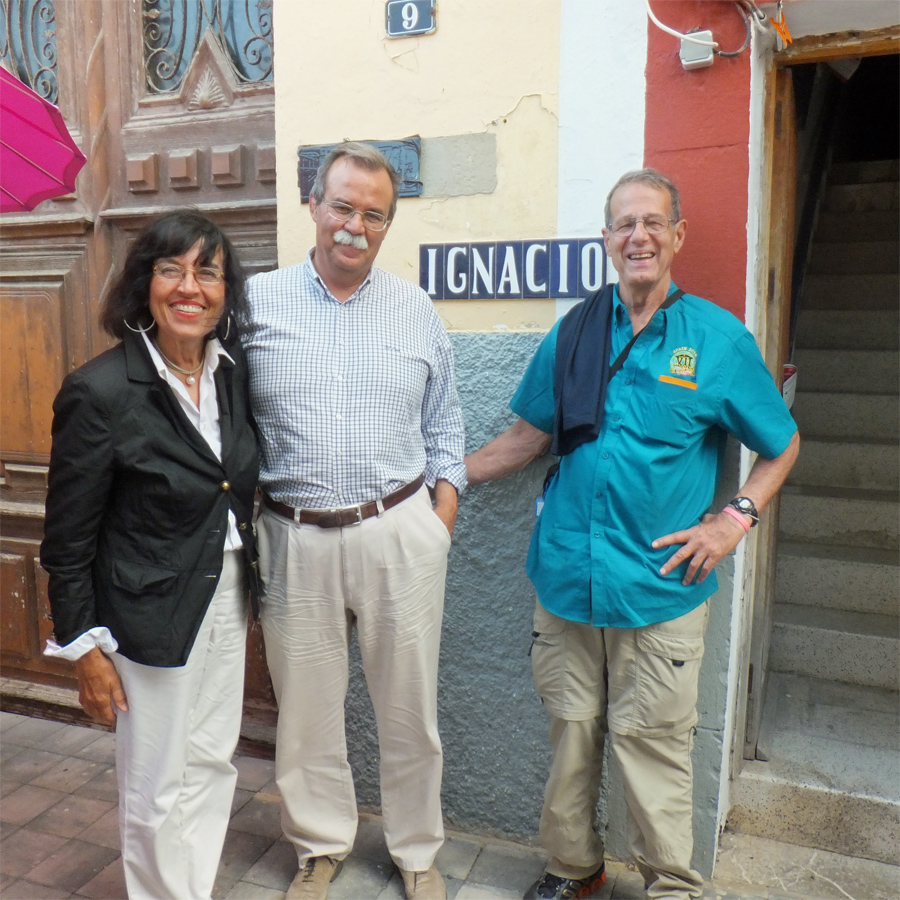
Left: El Guitarra Restaurant right in middle of
picture / Right: Maike and Ignacio, left
0530c-mm-DSC04819-main beach street of La
Vila-ed-1200w.jpg / 0530c-es-DSCF0739-with Maike and
Ignacio-ed-900s.jpg
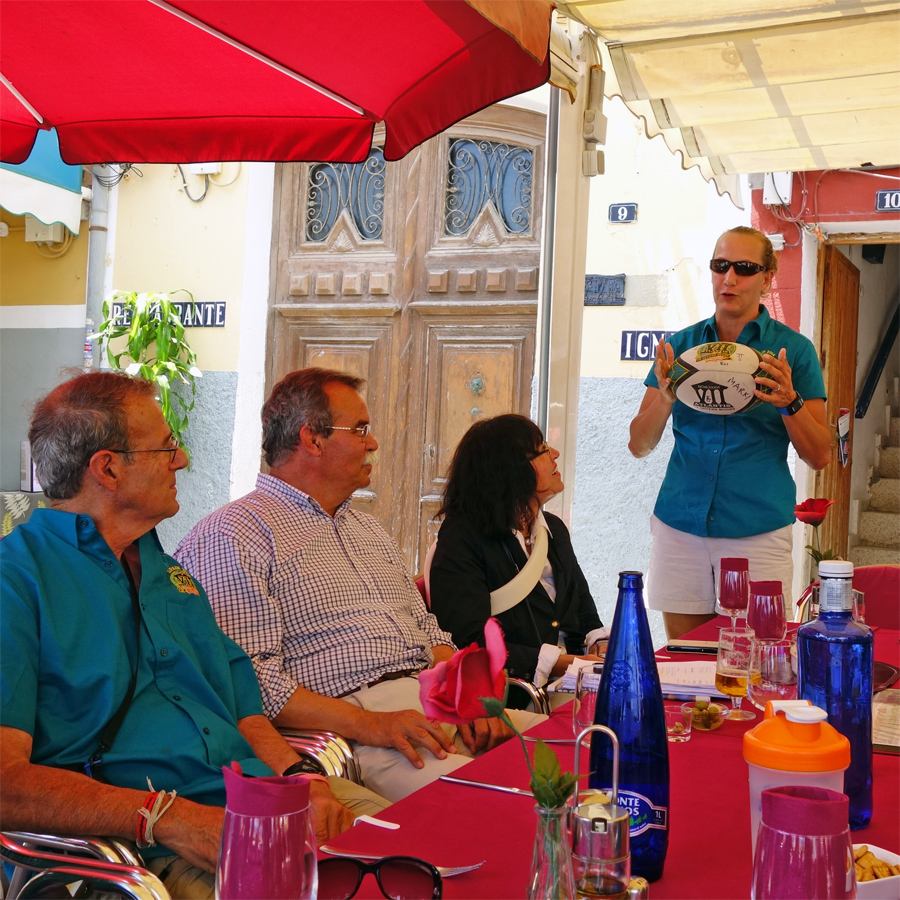
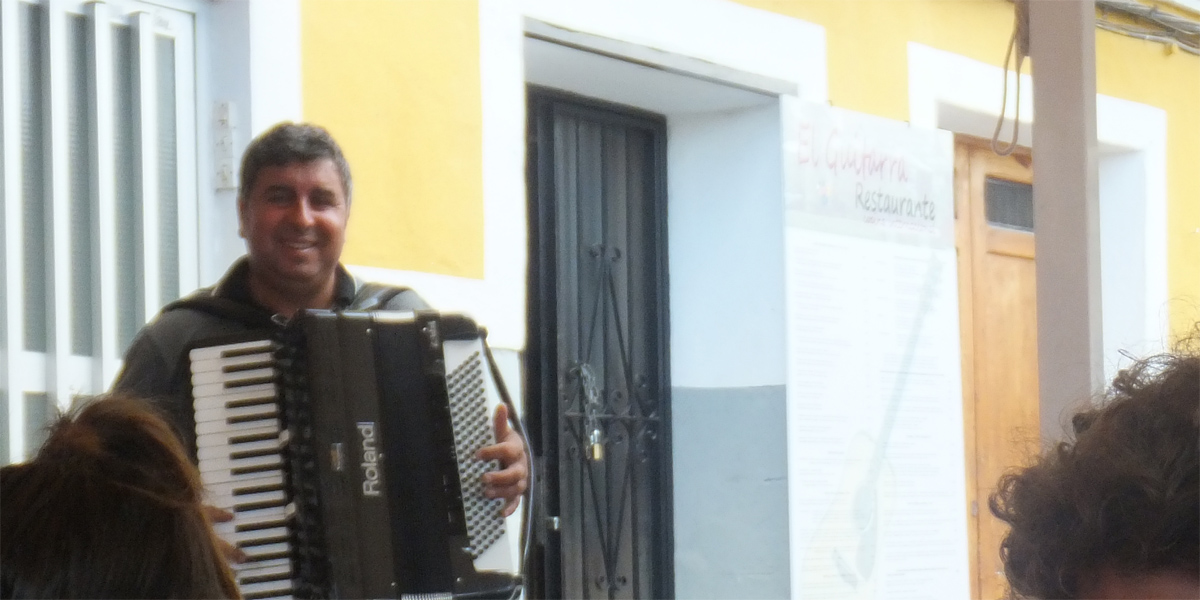 Left:
Dana thanks Ignacio / Right: Accordion player serenades us
0530c-mm-DSC04853-Dana presents Ignacio
ball-ed-900s.jpg / 0530c-es-DSCF0740-accordian
player-ed-1200w.jpg
Click on accordion
to see him play
Left:
Dana thanks Ignacio / Right: Accordion player serenades us
0530c-mm-DSC04853-Dana presents Ignacio
ball-ed-900s.jpg / 0530c-es-DSCF0740-accordian
player-ed-1200w.jpg
Click on accordion
to see him play
Here are a few pictures representative of our fare at this meal.
The final chapter of this saga may be found here: Atlantis in Spain-III

































